The 1960s were a revolutionary time for design, where living rooms became a canvas for bold creativity and innovation. Infused with vibrant colors, daring patterns, and futuristic elements, these spaces transcended mere functionality to become expressive reflections of individuality. From geometric shapes to eye-catching pop art, the era's interiors radiated a playful yet sophisticated energy. As you explore these 30 iconic 1960s living room ideas, you'll discover how seamlessly these iconic styles can be woven into modern homes, blending retro charm with contemporary flair to create spaces that are both nostalgic and timeless.
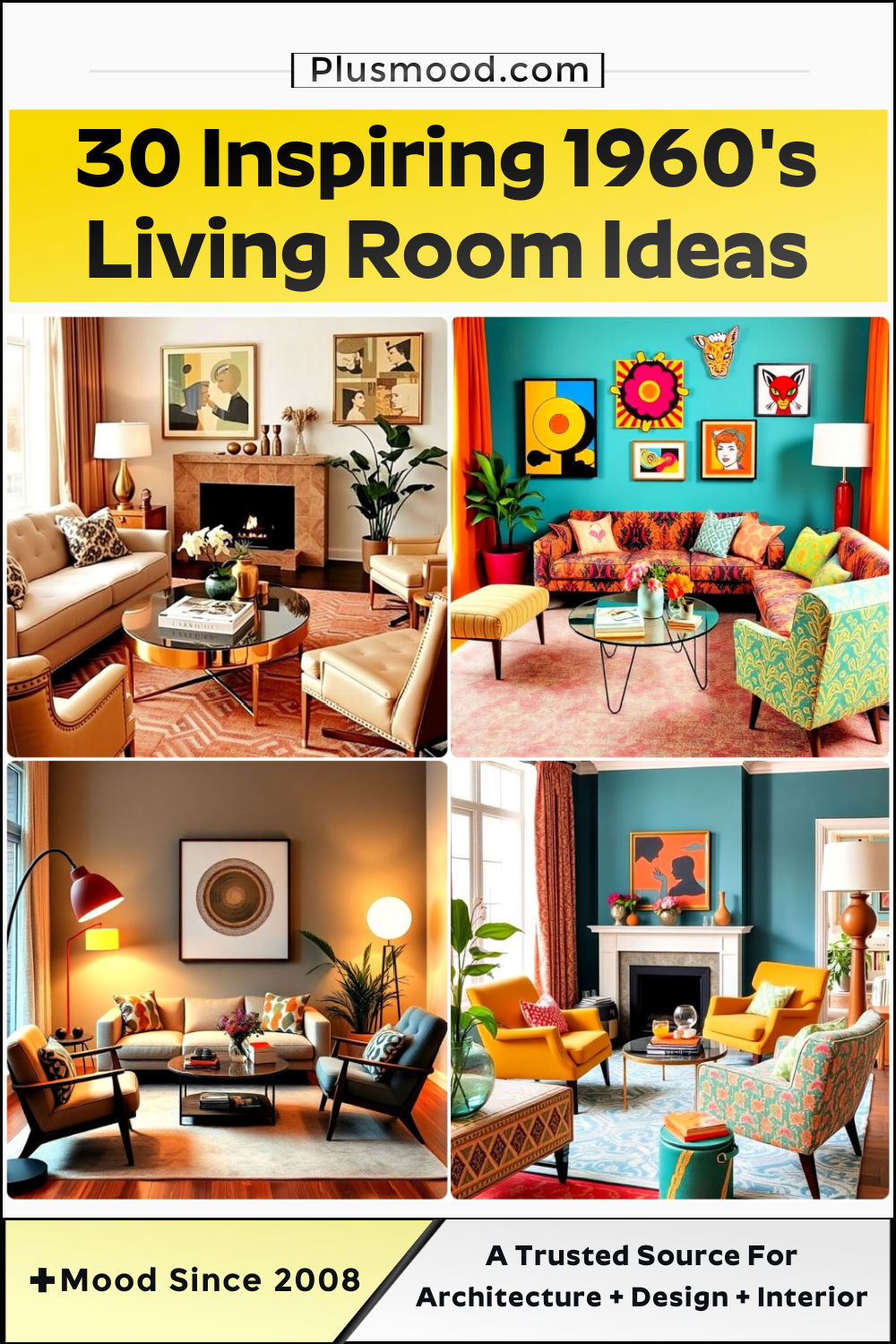
1. Retro Color Schemes
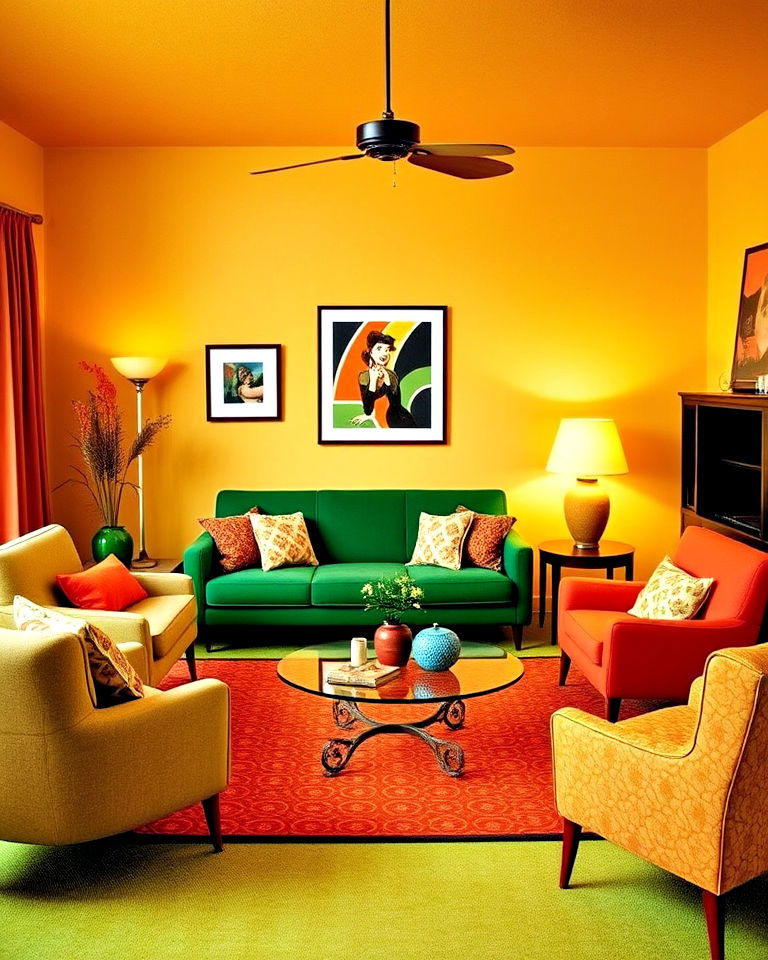
Bold and contrasting color schemes defined the 1960s living room. From mustard yellows and burnt oranges to avocado greens and deep browns, these palettes brought warmth and vibrancy to any space. The use of clashing colors was intentional, creating a playful yet cohesive look that captured the essence of the era. Adding these colors to modern furnishings can effortlessly channel the 1960s vibe, making a room feel both nostalgic and stylishly timeless.
2. Geometric Patterns
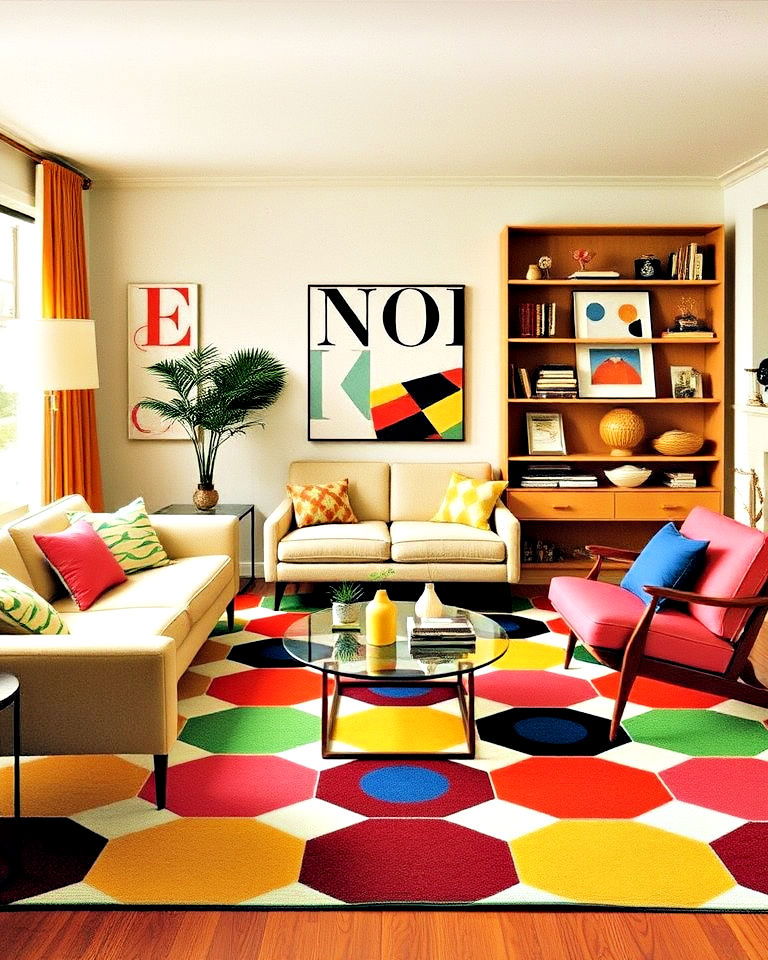
During the 1960s, geometric patterns became a defining feature of interior design, inspiring creative living room accent wall ideas. These patterns often included bold shapes like circles, squares, and hexagons in vibrant, contrasting colors. Incorporating these designs into your living room today can create a lively and energetic space that nods to the past while still feeling modern. Pairing geometric elements with solid-colored furniture helps balance the look.
3. Mid-Century Modern Furniture
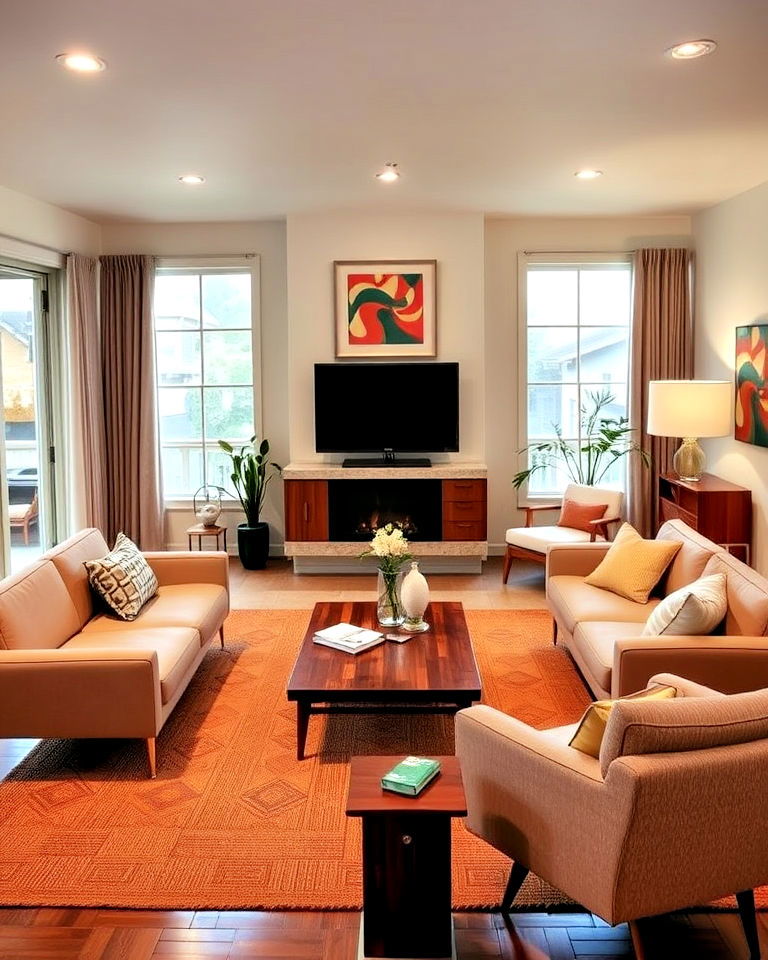
Step back in time with a nostalgic 1960s living room featuring iconic colors and patterns. In mid-century modern living rooms, clean lines, organic curves, and functional pieces dominated the design landscape, often paired with striking mid-century modern fireplace ideas. This style's furniture, often made from teak or walnut, blended simplicity with elegance. Adding pieces like low-profile sofas, sleek coffee tables, or wooden armchairs can transform any living room into a space that pays homage to the 1960s while maintaining a contemporary feel.
4. Sunken Conversation Pits
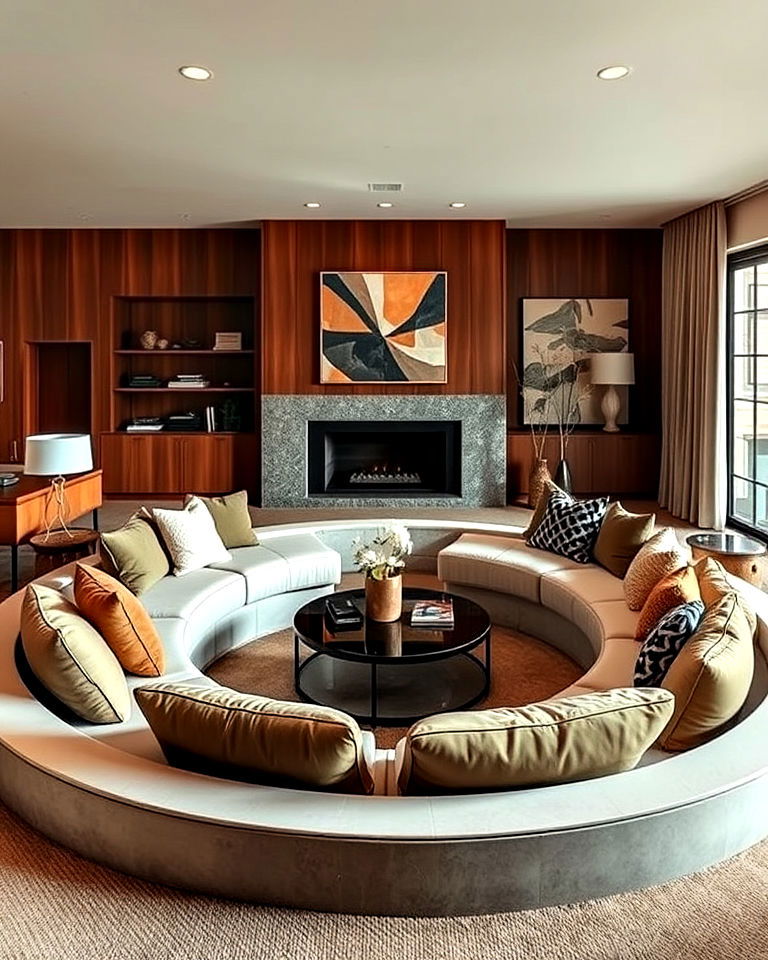
Sunken conversation pits were a quintessential feature in upscale 1960s homes, reflecting timeless sunken living room ideas that create cozy, intimate seating areas. These pits, often lined with plush cushions and arranged in a circular pattern, encouraged social interaction. Recreating this design element today, even on a smaller scale, adds a unique architectural detail that sparks conversation and makes gatherings feel more engaging.
5. Space Age Influences
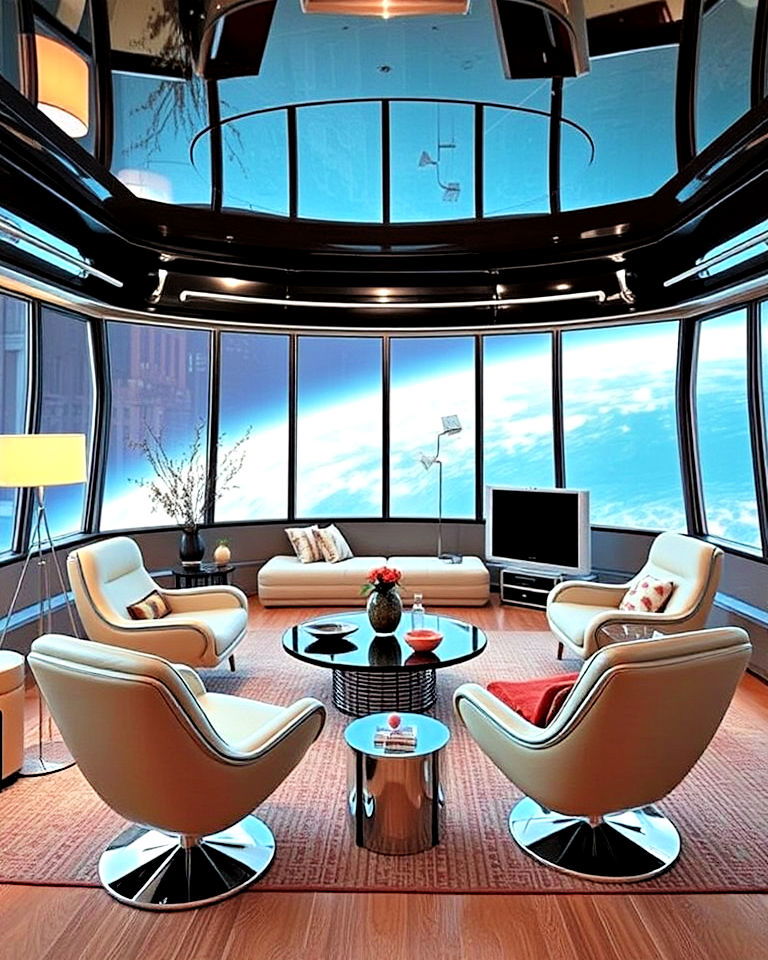
Space exploration captivated the world in the 1960s, influencing living room designs with futuristic shapes and materials. From sleek chairs that resemble spacecraft to metallic accents that reflect a space-age aesthetic, these elements brought a modern and innovative touch to interiors. Incorporating these designs today, with chrome details or curvy furniture, can give your living room a nostalgic yet forward-thinking space-age aesthetic.
6. Pop Art Accents
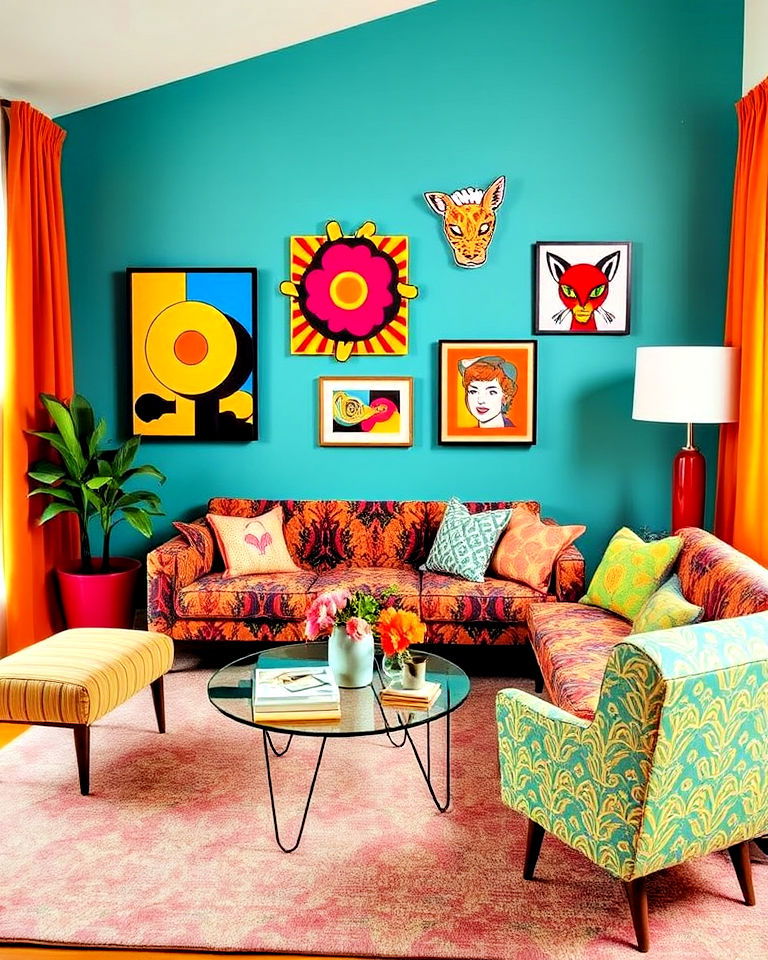
Inspired by artists like Andy Warhol and Roy Lichtenstein, pop art accents brought a burst of creativity into 1960s living rooms. Bright colors, bold prints, and playful motifs on wall art, pillows, and rugs became signature pop art accents. Incorporating pop art into your space can add a lively, whimsical feel while celebrating one of the most iconic art movements of the 20th century.
7. Modular Seating
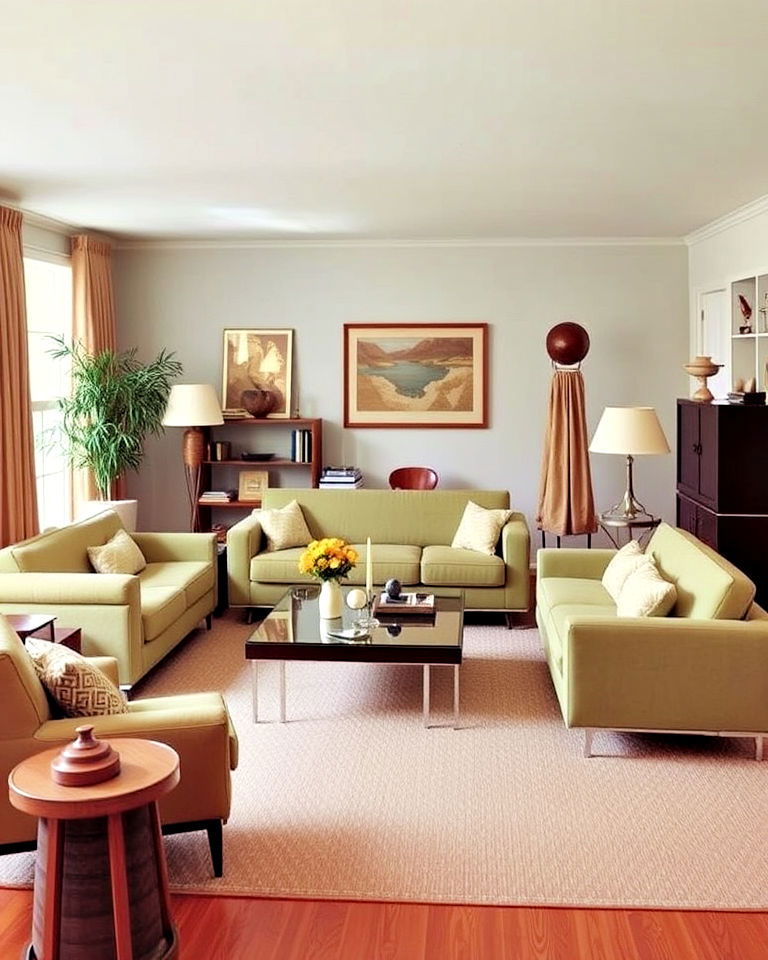
Modular seating was a game-changer in 1960s living room design, offering flexibility and style in one package. These versatile pieces allowed homeowners to rearrange seating to fit any occasion or space, making them ideal for both intimate gatherings and larger parties. Today, using modular furniture can add a dynamic element to your living room, seamlessly integrating with living room toy storage ideas for a functional setup.
8. Bold Wallpaper Designs
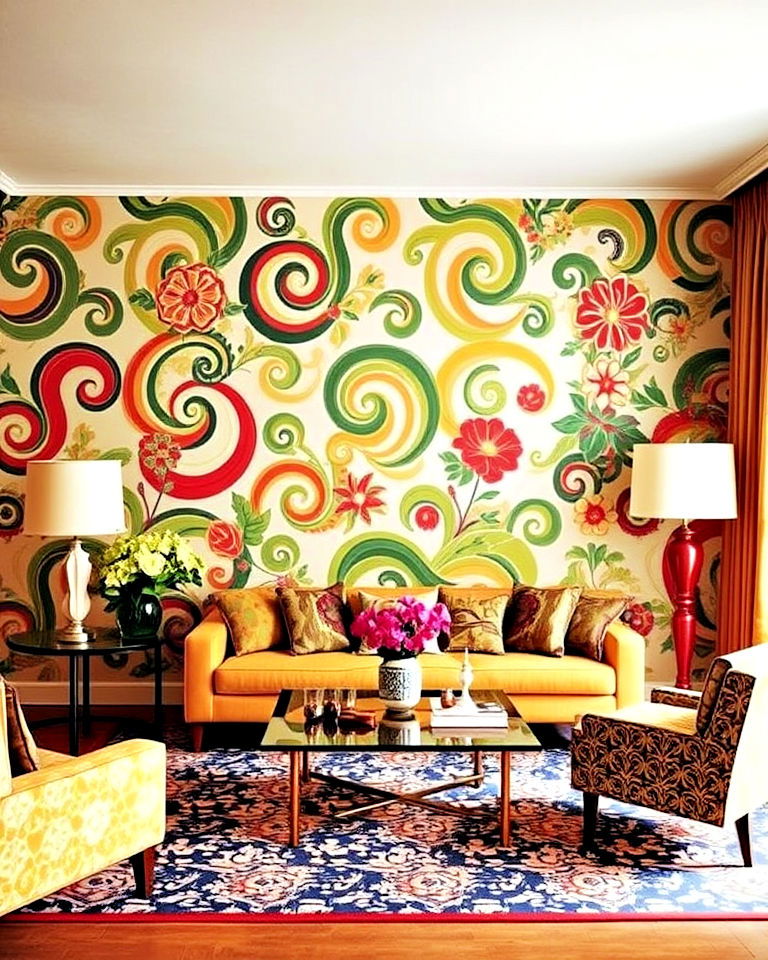
In the 1960s, walls became canvases for artistic expression, adorned with wallpapers in daring patterns and vivid colors. From psychedelic swirls to floral prints, these designs added drama and personality to any living room. Embracing bold wallpaper today can create a statement wall, inspired by creative wall covering ideas, that transforms the room's atmosphere with retro flair.
9. Shag Carpeting
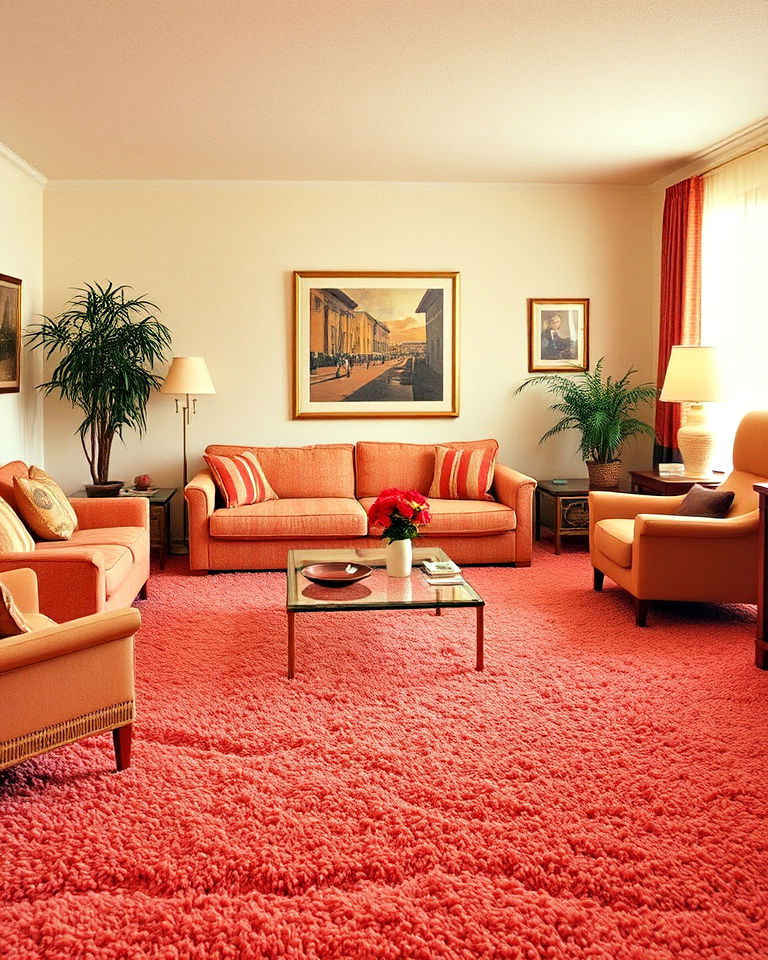
Bring retro flair into your space with a vibrant 60s living room design. Soft, plush, and often brightly colored, shag carpeting was a staple in 1960s living rooms, adding warmth and texture to the space. Its long fibers created a cozy feel underfoot, inviting relaxation and comfort. Bringing shag rugs into a modern setting can evoke a sense of nostalgia while also introducing a playful texture that enhances the room's overall aesthetic.
10. Low-Slung Furniture

Furniture in the 1960s often had a low-slung design, emphasizing horizontal lines and a close-to-the-ground profile. This style of seating created an open, laid-back atmosphere that encouraged relaxation. Incorporating low-slung sofas and chairs into your living room today can maintain that vintage vibe while also making the space feel spacious and uncluttered.
11. Lucite and Acrylic Pieces
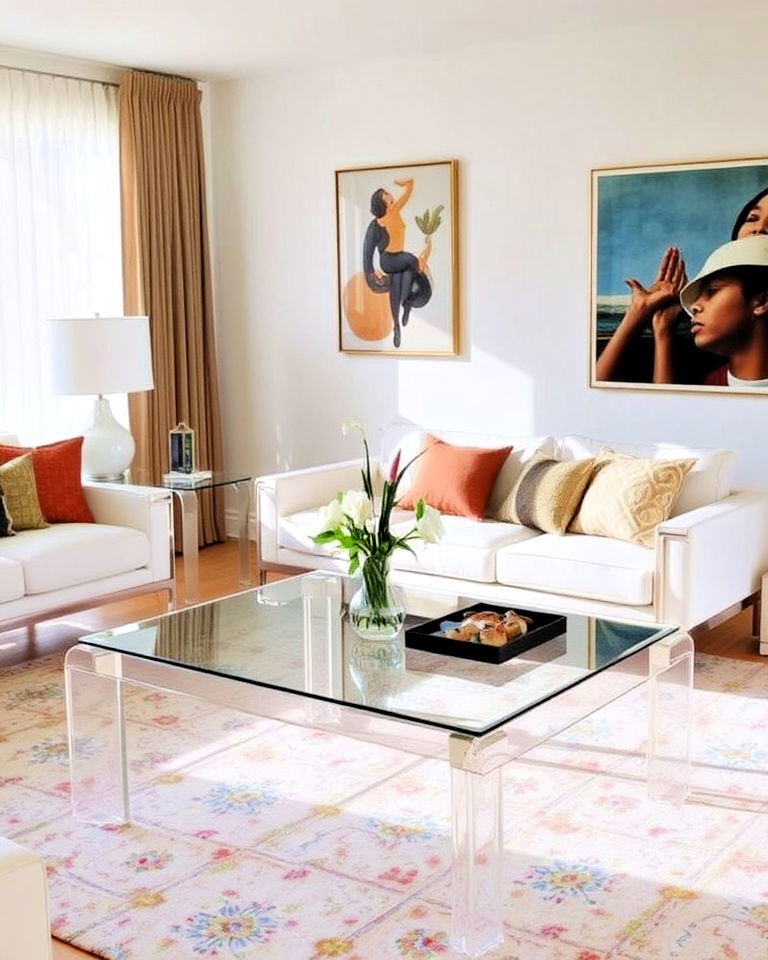
Lucite and acrylic furniture became popular in the 1960s for its transparent, modern look. Pieces like clear coffee tables, chairs, and lamps offered a futuristic feel while maintaining a sense of lightness and space. Adding Lucite elements to your living room can help keep the room airy and bright, blending seamlessly with other design styles without overwhelming the decor.
12. Funky Light Fixtures
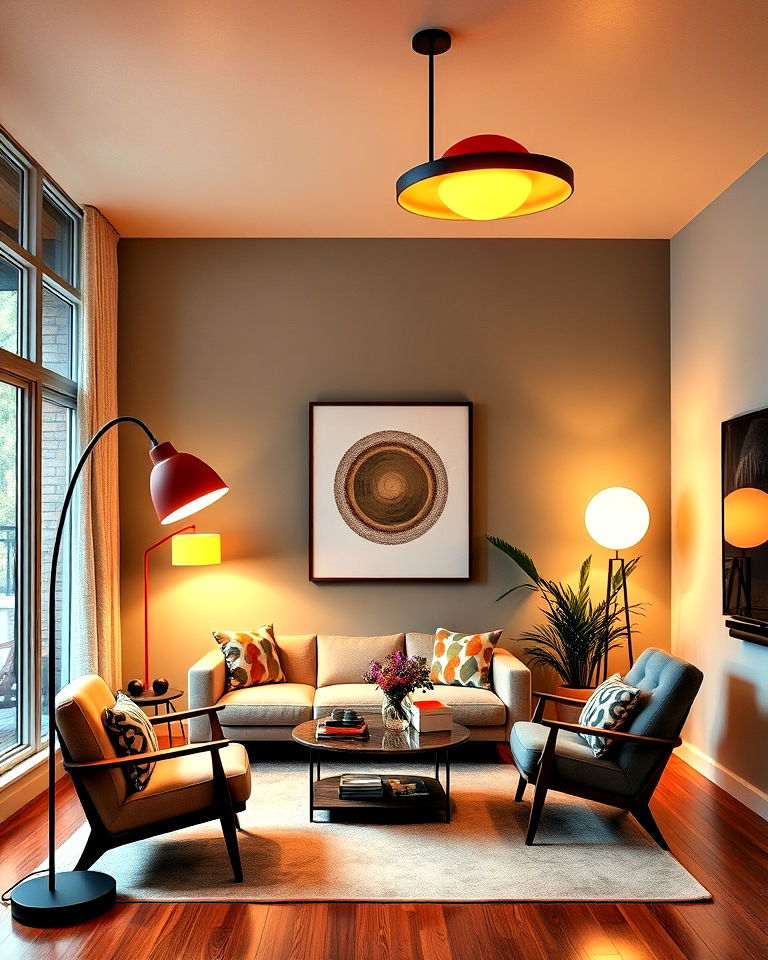
Lighting in the 1960s was all about unique shapes and vibrant colors, from pendant lights to floor lamps with curved arms. These fixtures often served as statement pieces, enhancing the room's mood with both illumination and style. Using retro-inspired light fixtures today can instantly add character to your living room, combining functional lighting with an artful touch.
13. Vinyl Records and Turntables
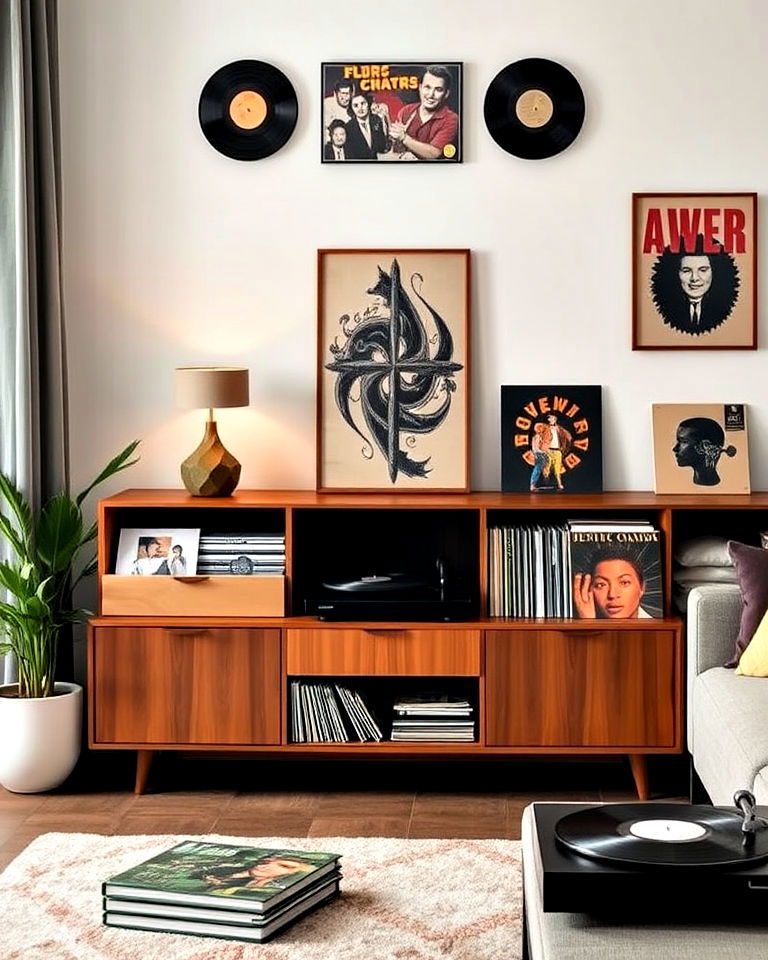
Vinyl records were not just a source of music but also a key decor element in 1960s living rooms. Record players became focal points, often accompanied by stylish storage units displaying album covers as part of the decor. Integrating a turntable and vinyl collection into your space now can create a nostalgic, tactile experience that celebrates both music and design heritage.
14. Abstract Art
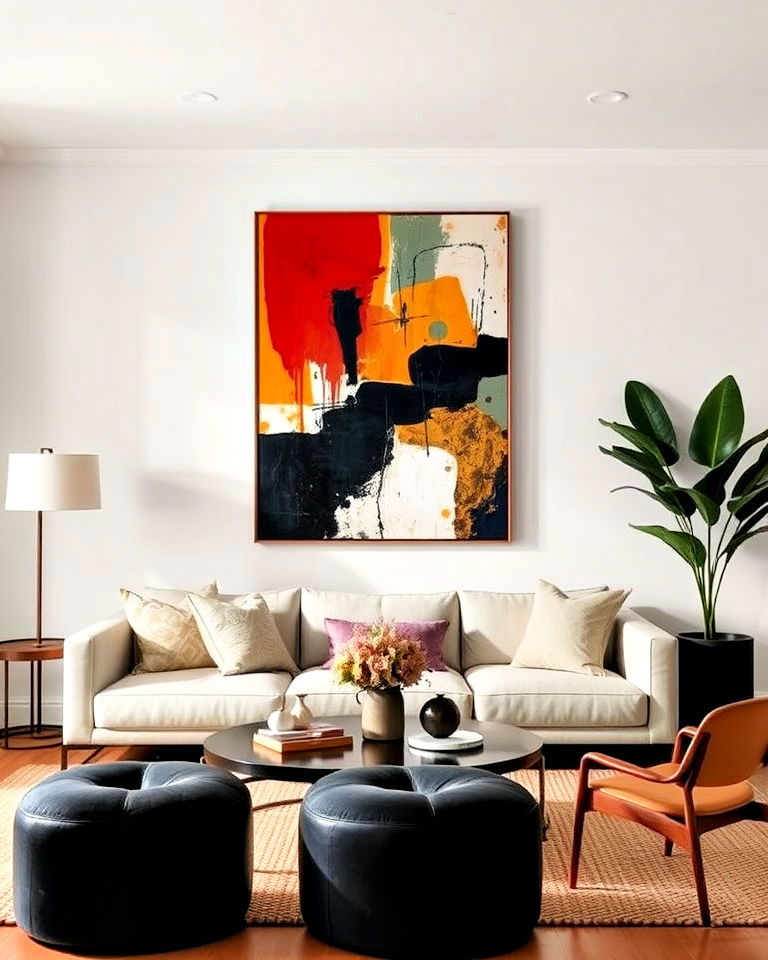
Add vintage charm with living room 1960s home decor for an authentic mid-century vibe. Abstract art gained popularity in the 1960s, with bold, expressive pieces that added a dramatic touch to living rooms. These artworks often featured striking colors and shapes, creating a focal point in the space. Incorporating abstract paintings or prints today can enhance your room's aesthetic, adding depth and a touch of mid-century modern elegance to the overall design.
15. Bean Bag Chairs
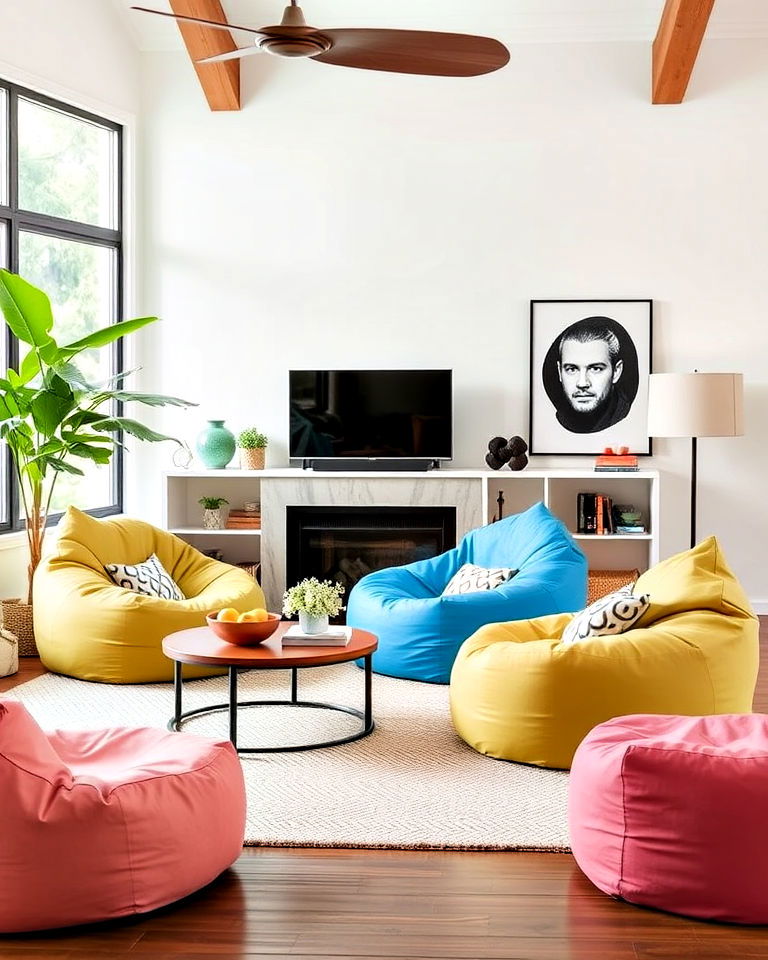
Bean bag chairs, introduced in the 1960s, became a symbol of laid-back, casual comfort. These playful seating options offered flexibility and were available in a variety of colors and materials. Bringing bean bags into your living room today can add a whimsical touch while providing extra seating that's both fun and functional for guests of all ages.
16. Wooden Paneling
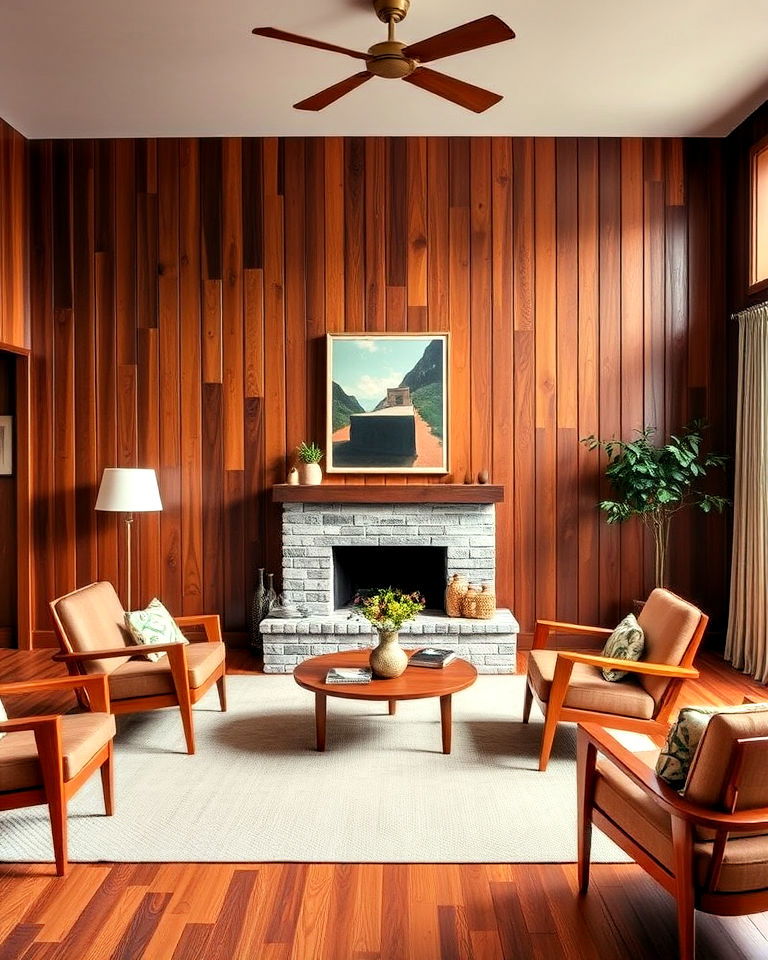
Wooden paneling was a popular design element in 1960s living rooms, often seen covering entire walls in rich, dark tones. It added warmth and texture to spaces, creating a cozy, inviting feel. Today, using wooden accents or feature walls can bring a touch of mid-century charm into your living room while offering a versatile backdrop that complements both modern and retro decor styles.
17. Sculptural Decor

Sculptural decor pieces, from metal wall art to ceramic vases, were integral to 1960s living rooms. These items often featured abstract or organic shapes that doubled as conversation starters. Introducing sculptural elements into your living room today can add a layer of artistic sophistication, highlighting the space's design while maintaining a link to the playful creativity of the era.
18. Bold Accent Chairs
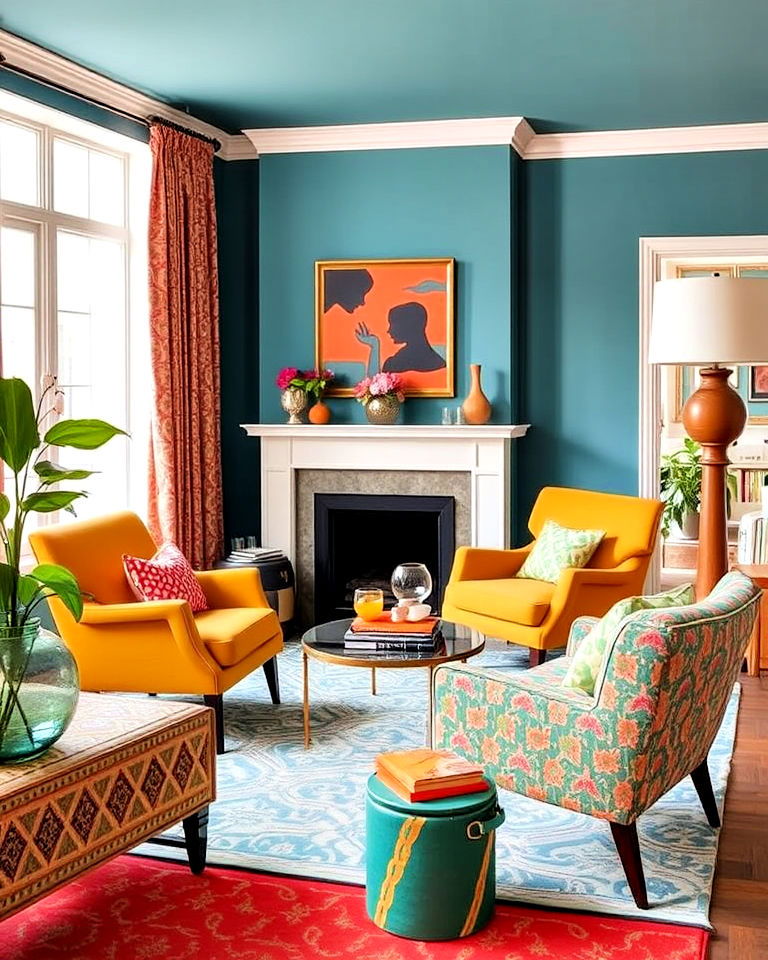
Capture the essence of a typical 1960s living room with bold colors and sleek lines. Accent chairs in the 1960s were all about making a statement with bold colors, unusual shapes, and unique fabrics. These chairs became focal points that added personality to the living room. Incorporating a vibrant accent chair today can instantly lift your space, adding a pop of color and a hint of vintage charm that complements more neutral furnishings.
19. Macrame and Wall Hangings
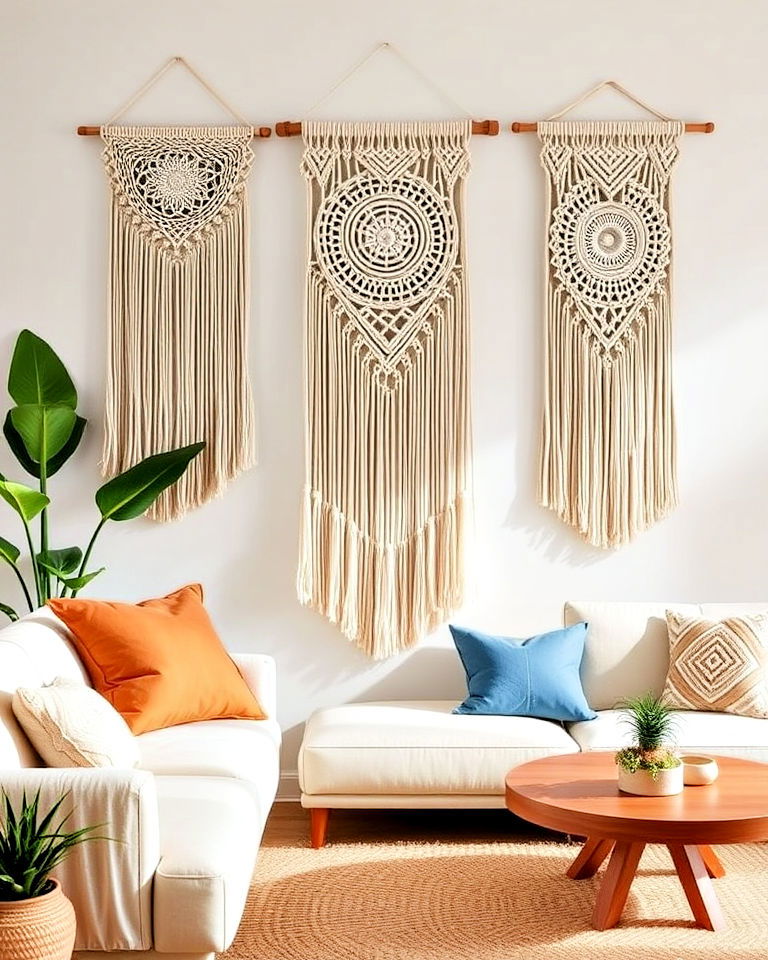
Macrame and other textile wall hangings became iconic decor elements in the 1960s, bringing a touch of bohemian style into the home. These handcrafted pieces added texture and a natural feel to the space. Reintroducing macrame today can soften modern interiors, blending retro influences with contemporary trends in a way that feels both nostalgic and fresh.
20. Bar Carts and Cocktail Stations
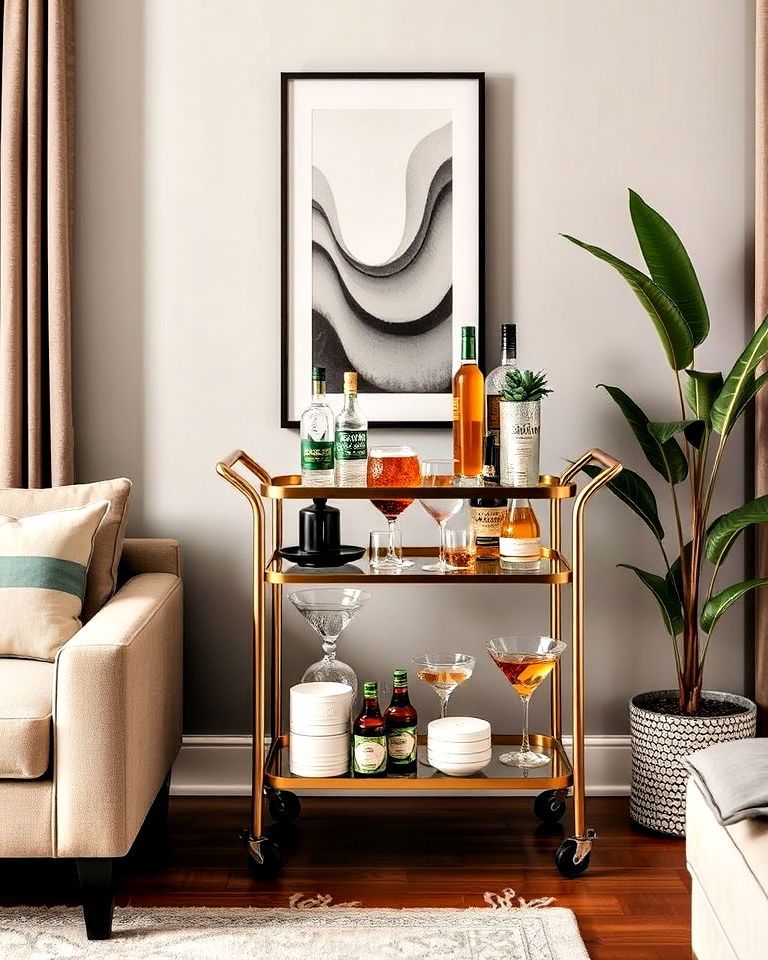
The 1960s saw a rise in at-home entertaining, with bar carts and cocktail stations becoming a stylish necessity in living rooms. These portable drink stations were both functional and decorative, often stocked with colorful glassware and spirits. Adding a vintage-inspired bar cart to your space today can enhance your entertaining setup, offering a touch of elegance and practicality for gatherings.
21. Futuristic Plastic Chairs
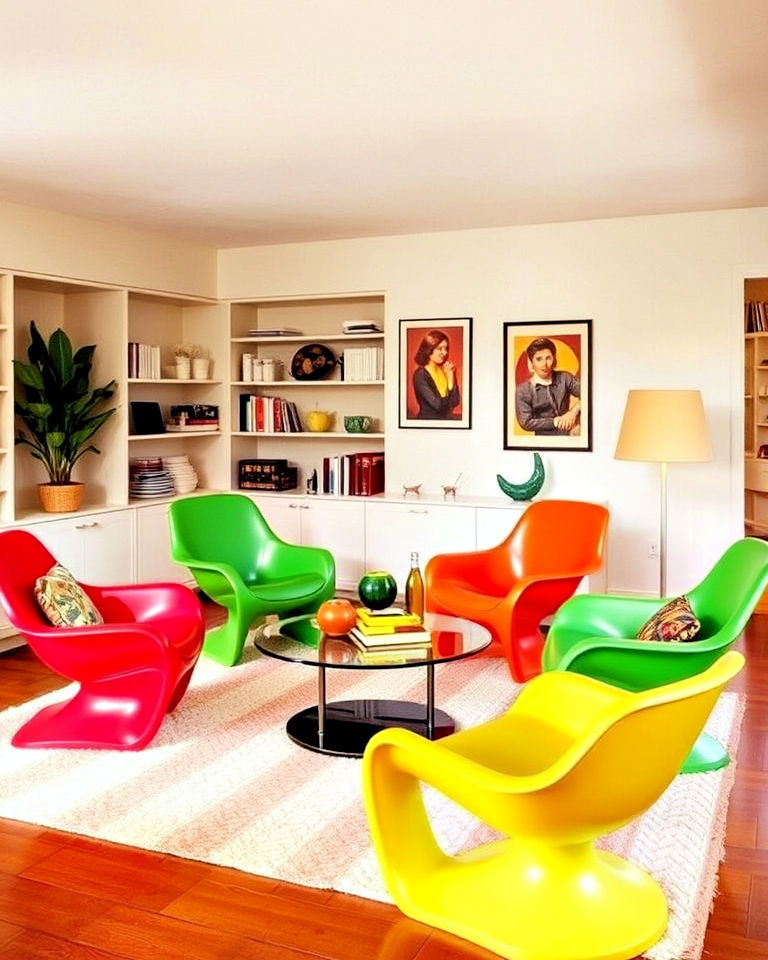
Plastic chairs in bold, vibrant colors were a futuristic innovation in the 1960s, often molded into sleek, ergonomic shapes. These chairs represented the era's fascination with new materials and modern design. Incorporating similar styles into your living room today can create a unique, eye-catching seating option that adds both comfort and a playful nod to retro trends.
22. Op Art Prints
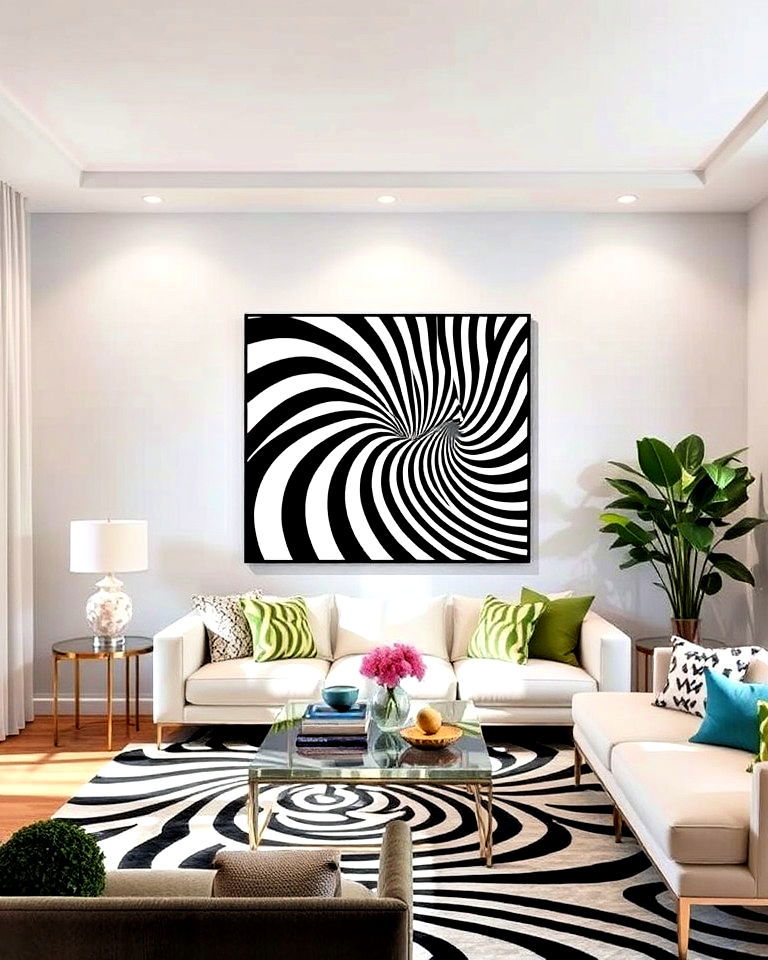
Op Art, or Optical Art, captivated the 1960s with its mind-bending patterns and visual illusions. These prints played with color and geometric designs to create dynamic, almost moving effects. Including Op Art in your living room, whether through wall art or decorative accents, can add a sense of movement and visual intrigue, keeping the space lively and engaging.
23. Low Coffee Tables
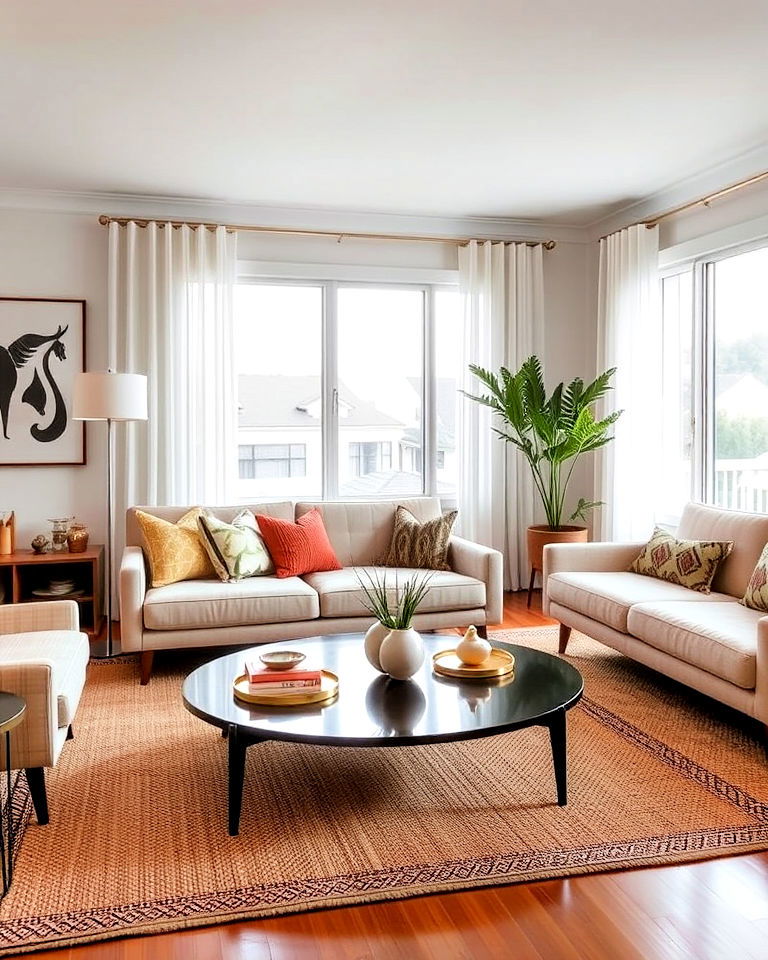
Low coffee tables were a defining feature of 1960s living rooms, often paired with low-slung sofas and complemented by living room fireplace ideas for a cohesive look. These tables typically featured clean lines and minimalist designs. Incorporating a low-profile coffee table today can enhance the flow of your living room, making it feel more open and connected while maintaining a touch of mid-century elegance.
24. Bold Draperies

Embrace timeless style with living room 1960s interior design for a classic, retro feel. Bold draperies in the 1960s often featured bright colors, large patterns, and heavy fabrics, serving as a significant design element in living rooms. These curtains not only framed the windows but also added to the room's overall aesthetic. Using retro-style drapes now can bring a touch of drama and color to your space, perfectly tying together the room's vintage vibe.
25. Organic Forms
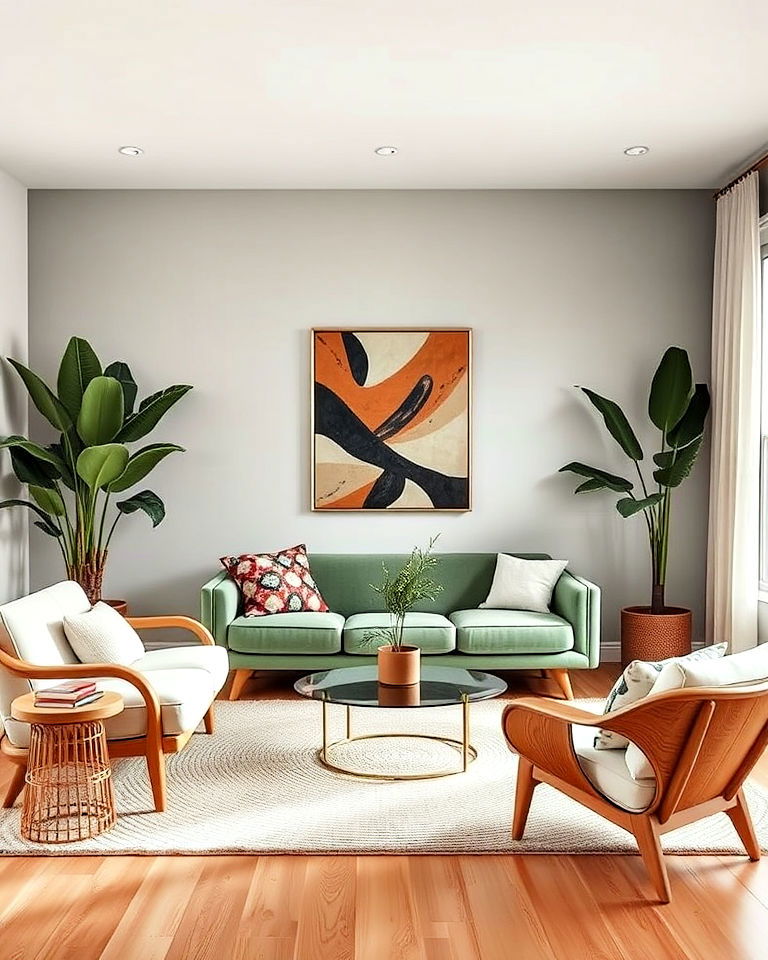
The 1960s embraced organic forms, with furniture and decor pieces inspired by natural shapes and flowing lines. This trend brought a sense of fluidity and harmony to living room designs. Integrating furniture with soft curves and natural materials today can create a welcoming and relaxed atmosphere that feels both retro and contemporary.
26. Patterned Area Rugs
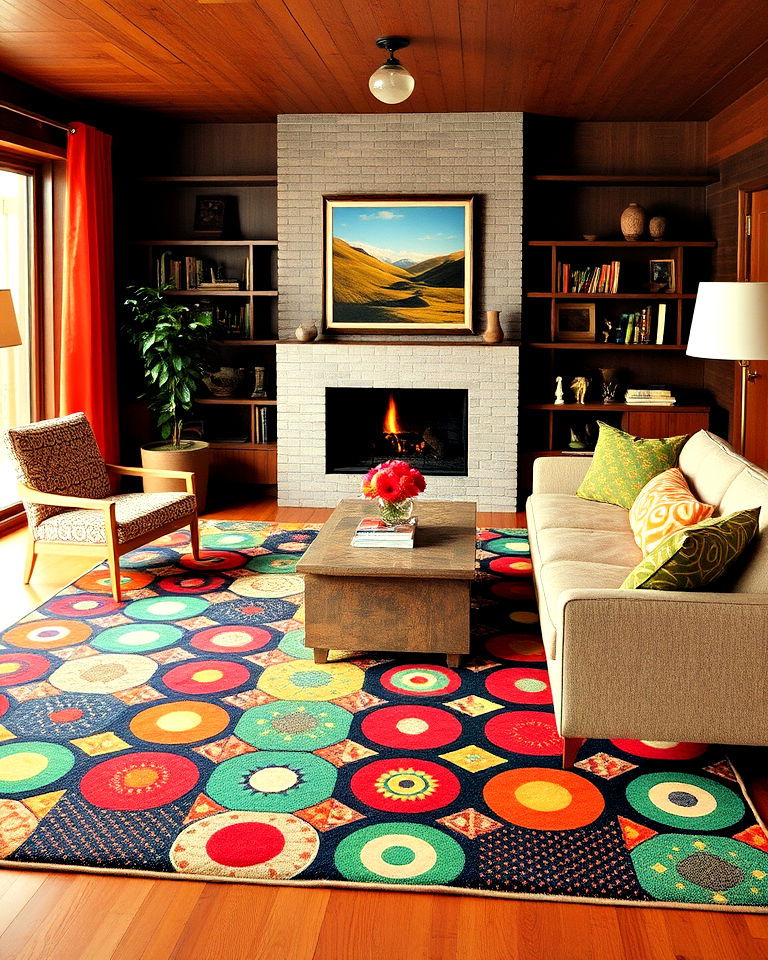
Patterned area rugs were essential in 1960s living rooms, often showcasing bold designs and bright colors that tied the entire room together. These rugs added warmth and a focal point to the space. Using a vintage-inspired rug today can ground your living room's decor, adding texture and a splash of color that aligns with living room flooring ideas.
27. Textured Upholstery
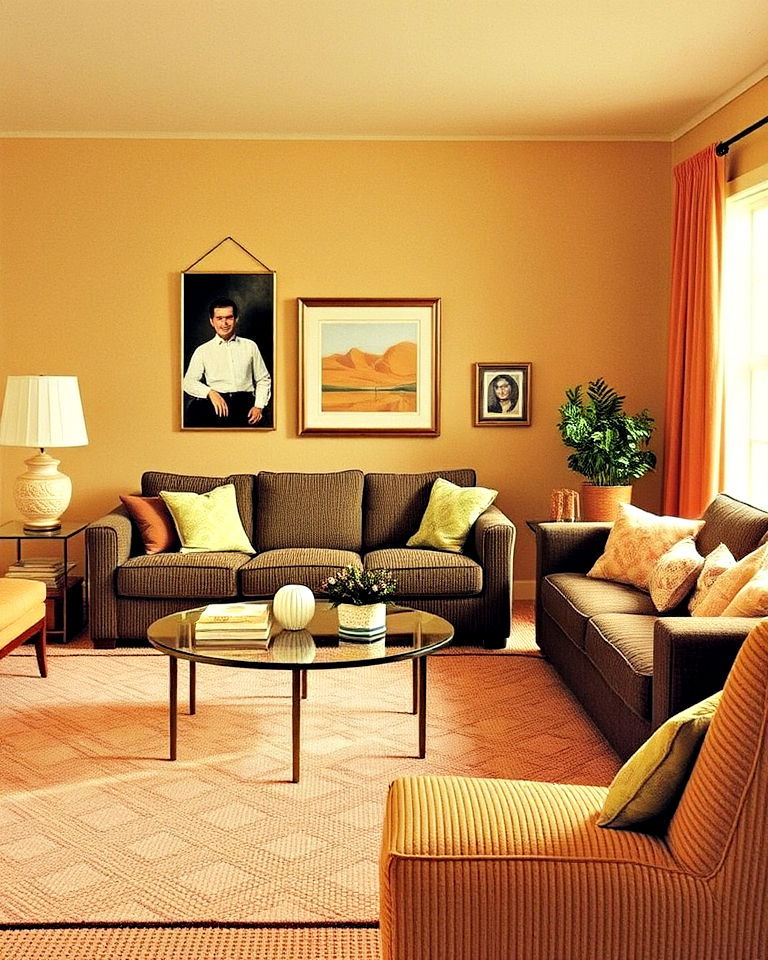
Upholstery in the 1960s featured a variety of textures, from velvet and corduroy to woven fabrics. These materials added tactile interest to sofas, chairs, and cushions, enhancing the room's comfort and style. Incorporating textured upholstery in your living room today can bring a touch of retro charm while offering a cozy, inviting feel that encourages relaxation.
28. Sleek Storage Units
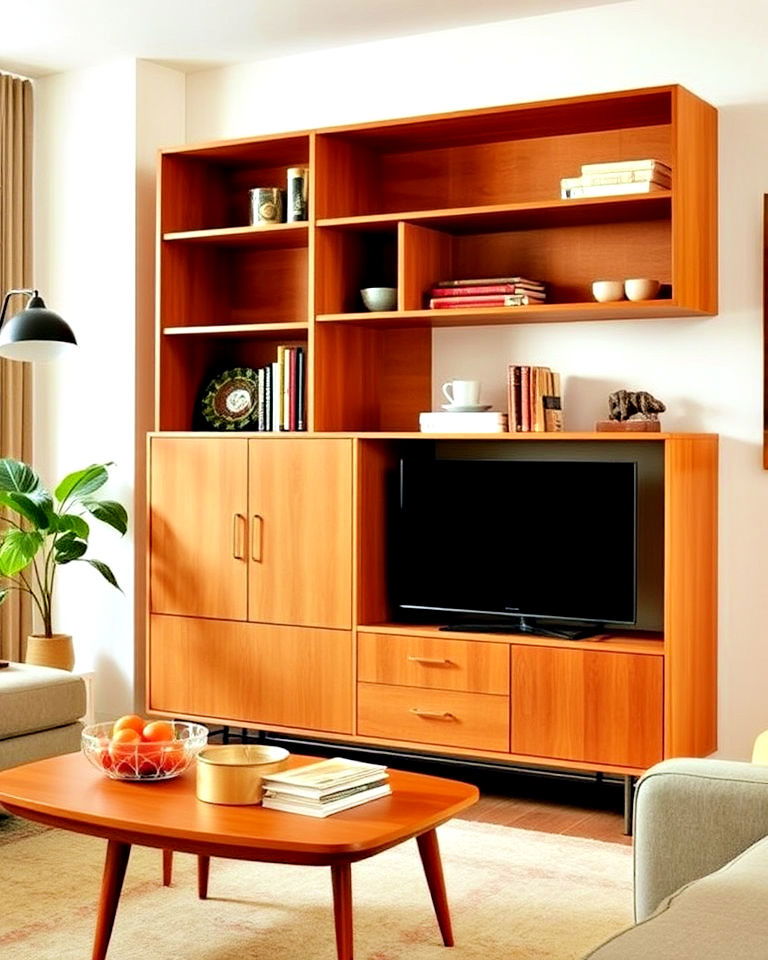
Sleek storage units with minimalist designs were a practical yet stylish addition to 1960s living rooms. These pieces often featured clean lines and natural wood finishes, blending functionality with aesthetics. Including similar storage solutions now can help keep your space organized while maintaining a streamlined look that complements both vintage and modern decor.
29. Hanging Chairs

Furnish your space with authentic 1960s living room furniture for a true mid-century look. Hanging chairs became a symbol of the free-spirited 1960s, combining comfort with a playful sense of movement. These chairs, often made of rattan or plastic, created a unique seating option that felt both relaxed and stylish. Adding a hanging chair to your living room today can bring an element of fun and relaxation, making it a standout feature that invites people to sit and unwind.
30. Metallic Accents
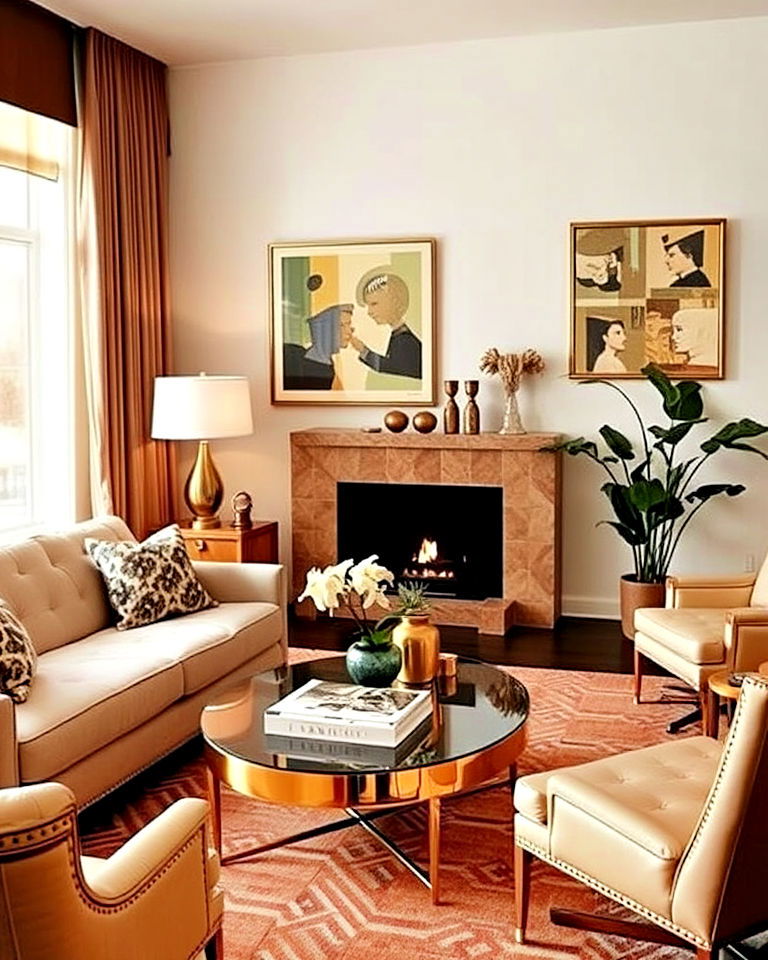
Metallic accents like brass, chrome, and gold were widely used in 1960s living rooms to add a touch of glamour and sophistication. These shiny finishes on lamps, tables, and decorative objects helped brighten the space and add visual interest. Incorporating metallic details today can elevate your living room's decor, creating a bridge between retro charm and modern elegance.
Conclusion:
Bringing 1960s living room design ideas into your home offers a dynamic way to infuse your space with a touch of retro elegance. From mid-century modern furniture to bold patterns and vibrant colors, these elements not only pay tribute to a bygone era but also provide a fresh take on interior styling that feels surprisingly relevant today. Whether you opt for geometric patterns or a sunken conversation pit, embracing these design ideas can transform your living room into a stylish haven that reflects both your personality and the enduring appeal of 1960s aesthetics.
Key Points:
- Bold Color Schemes: Vibrant and contrasting colors like mustard yellow, avocado green, and burnt orange were essential to 1960s living rooms, adding warmth and energy.
- Geometric Patterns: The use of geometric shapes and patterns on walls, rugs, and furnishings was a significant trend, creating dynamic visual interest.
- Mid-Century Modern Furniture: Clean lines, organic curves, and low-profile furniture pieces dominated the era, blending style with functionality.
- Innovative Design Features: Unique elements like sunken conversation pits and modular seating emphasized both social interaction and flexibility.
- Pop Art and Abstract Influences: Incorporating bold, expressive artwork and playful pop art accents helped define the aesthetic of the time.
- Futuristic and Space Age Elements: The 1960s embraced a futuristic vibe through Lucite furniture, metallic accents, and space-age-inspired designs.
- Textured and Patterned Decor: From shag carpets to bold draperies, textured and patterned elements brought tactile richness to living rooms.
- Sculptural and Organic Forms: Sculptural decor and furniture with soft curves added an artistic touch, blending natural shapes with modern design.
- Retro Lighting and Accessories: Distinctive light fixtures, vinyl records, and hanging chairs were used to create a playful yet stylish atmosphere.
What to Do Next:
- Identify Your Style Preferences: Decide which elements from the 1960s design ideas resonate with your taste to create a cohesive look in your living room.
- Start Small with Accents: Introduce retro elements like bold patterns or pop art in small doses through accessories like cushions, rugs, or wall art.
- Mix Modern with Retro: Combine these vintage styles with modern pieces to keep your space fresh and avoid a purely nostalgic look.
- Focus on Key Elements: Prioritize adding mid-century modern furniture and vibrant color schemes to instantly capture the essence of 1960s design.
- Experiment with Texture: Use textured upholstery, shag carpets, or sculptural decor to add depth and dimension to your living room.
These steps will help you seamlessly blend the charm of the 1960s with a contemporary twist, creating a unique living space that feels both timeless and trendy.

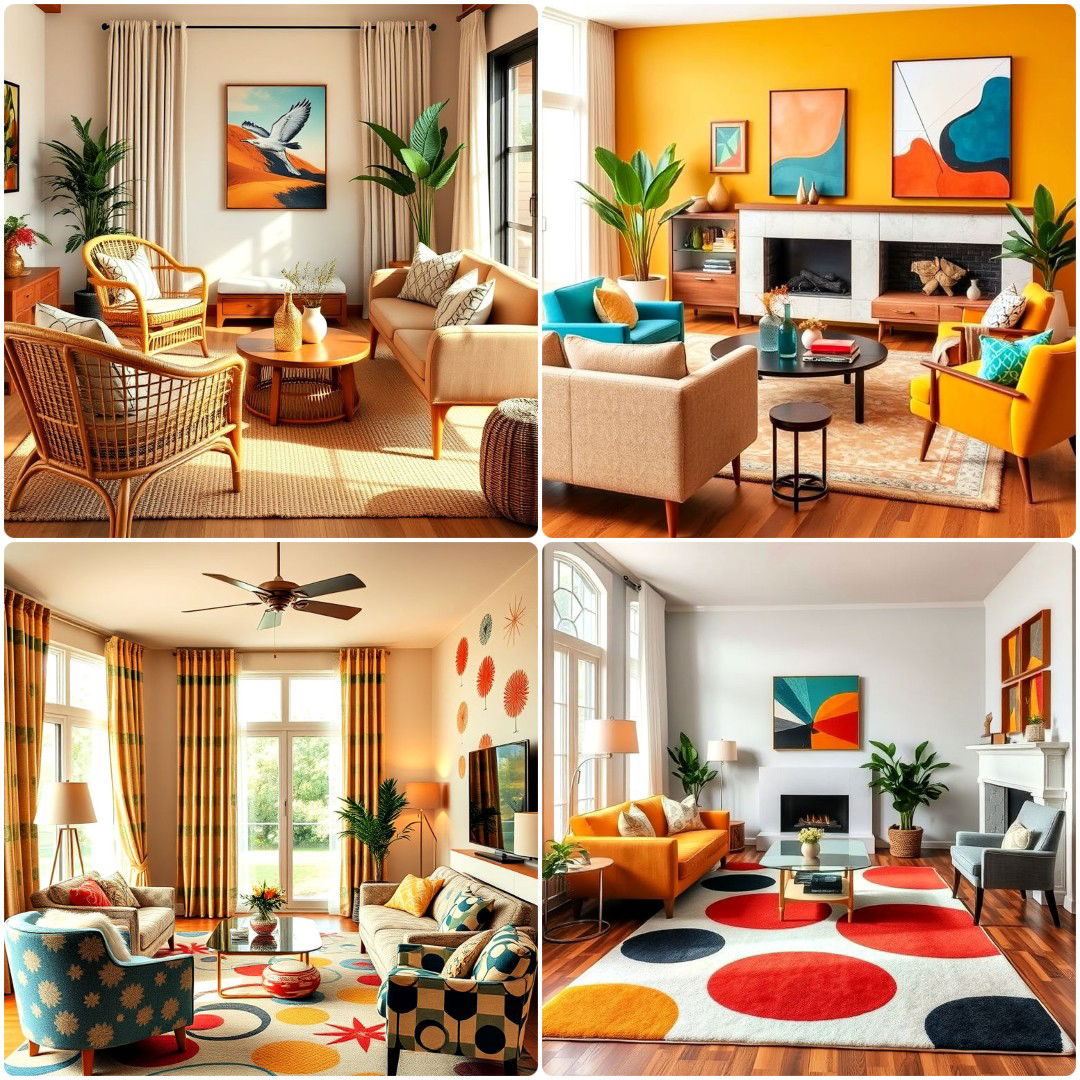
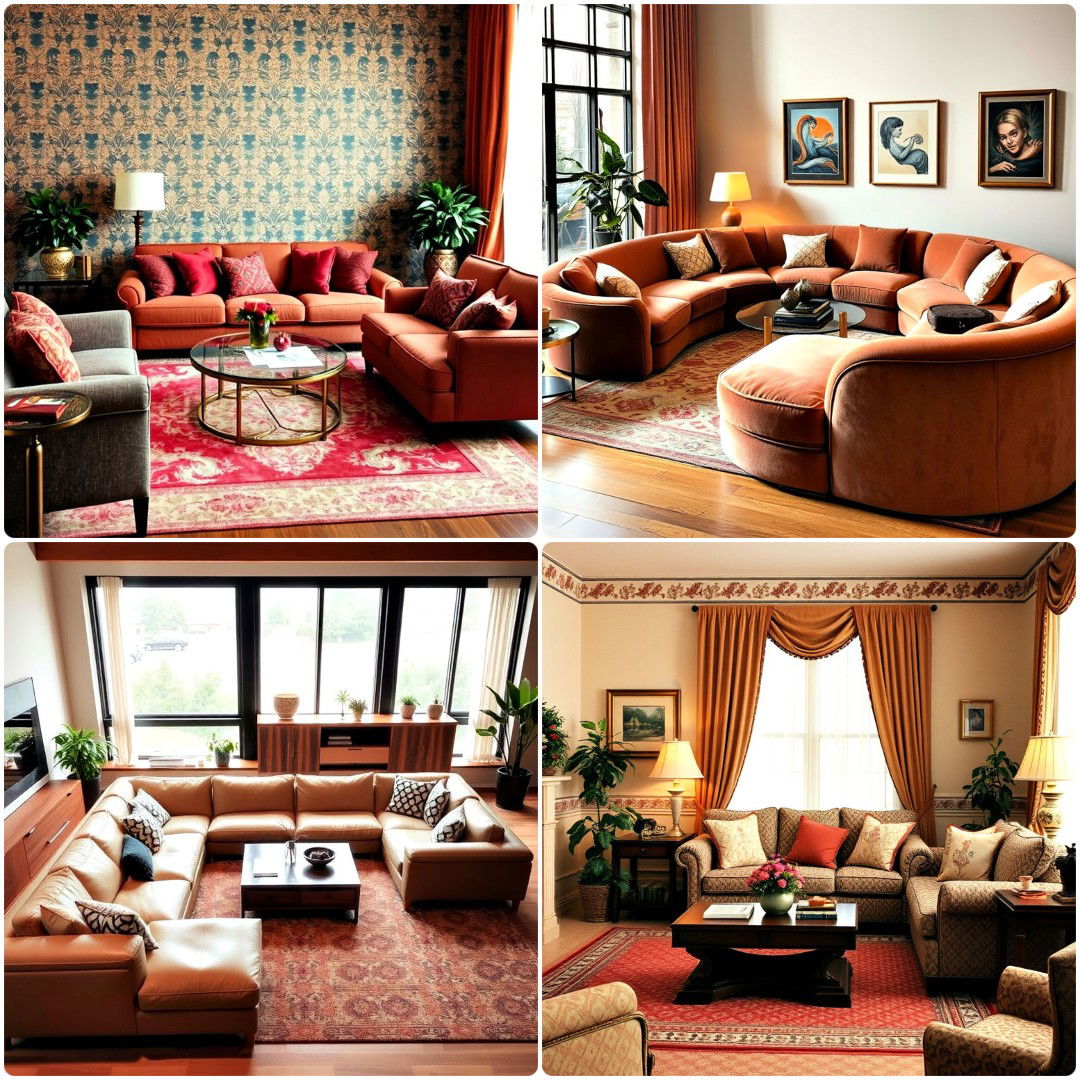
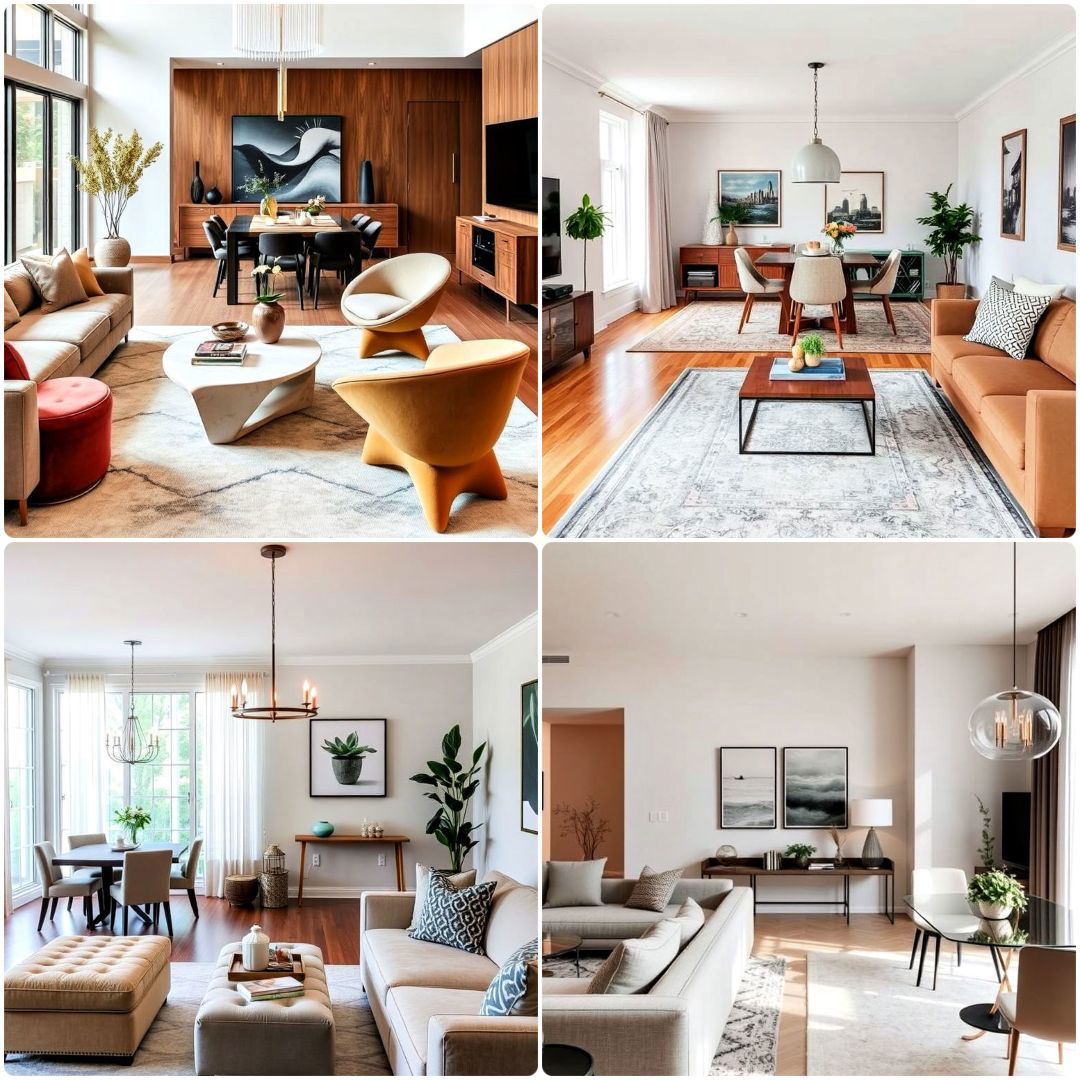
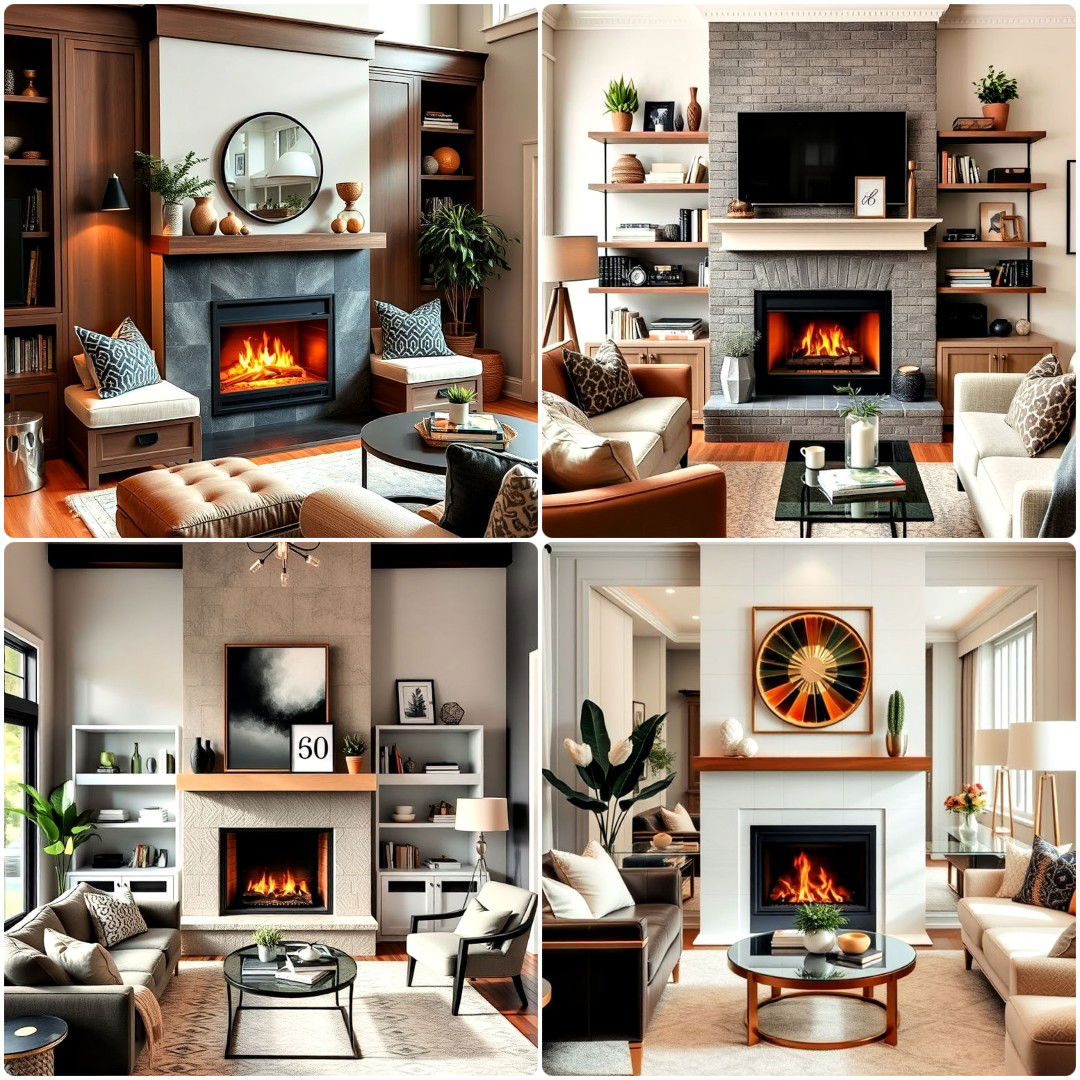
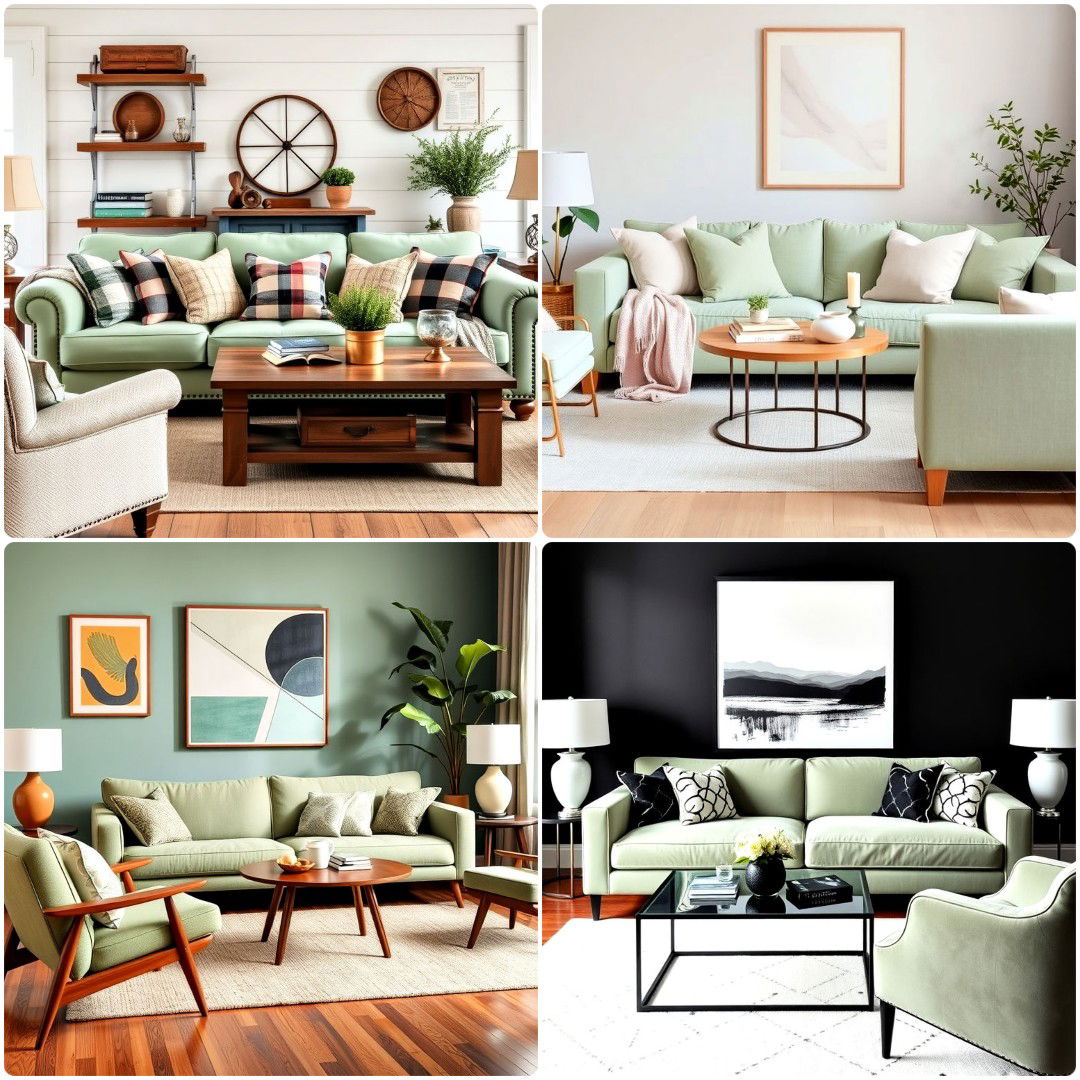
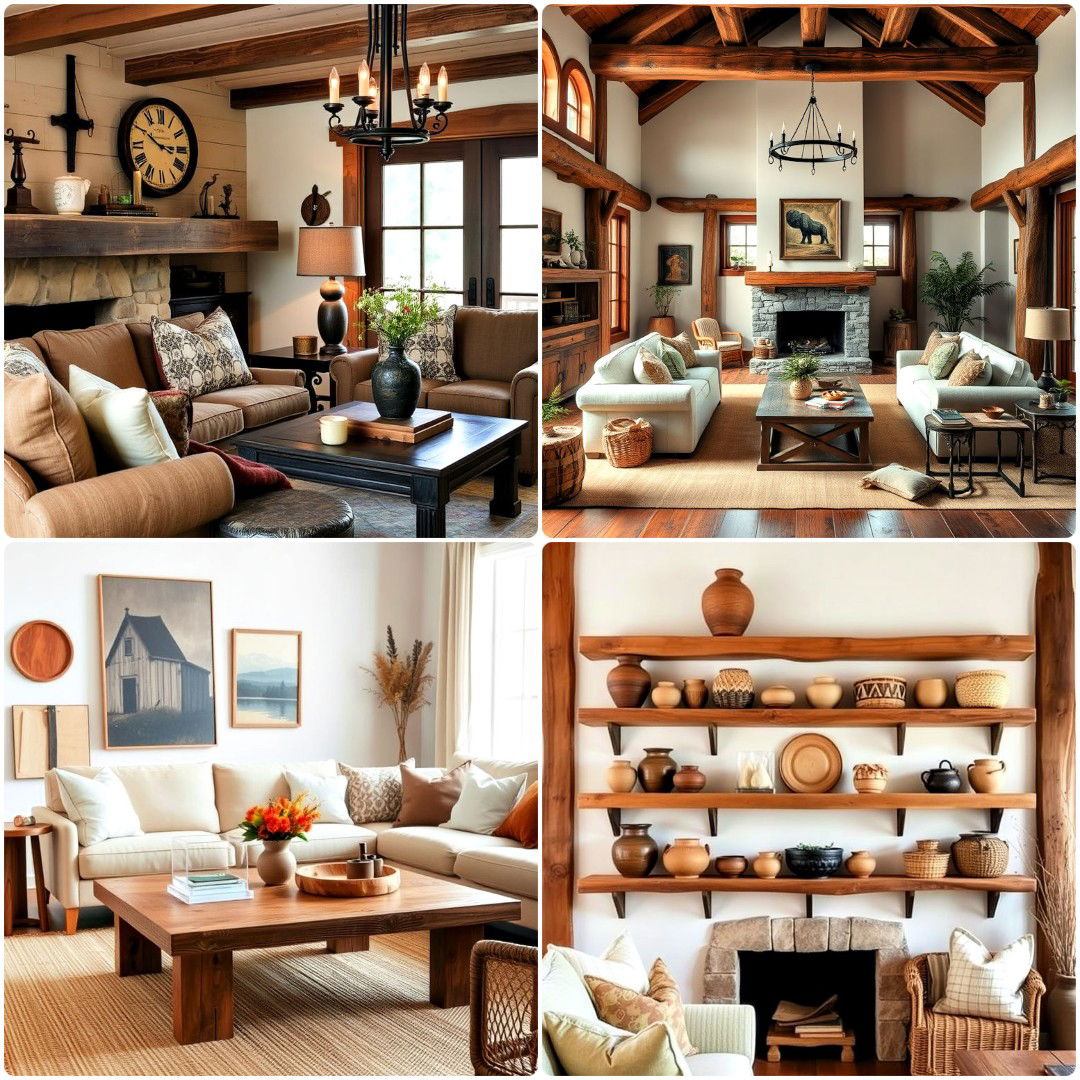
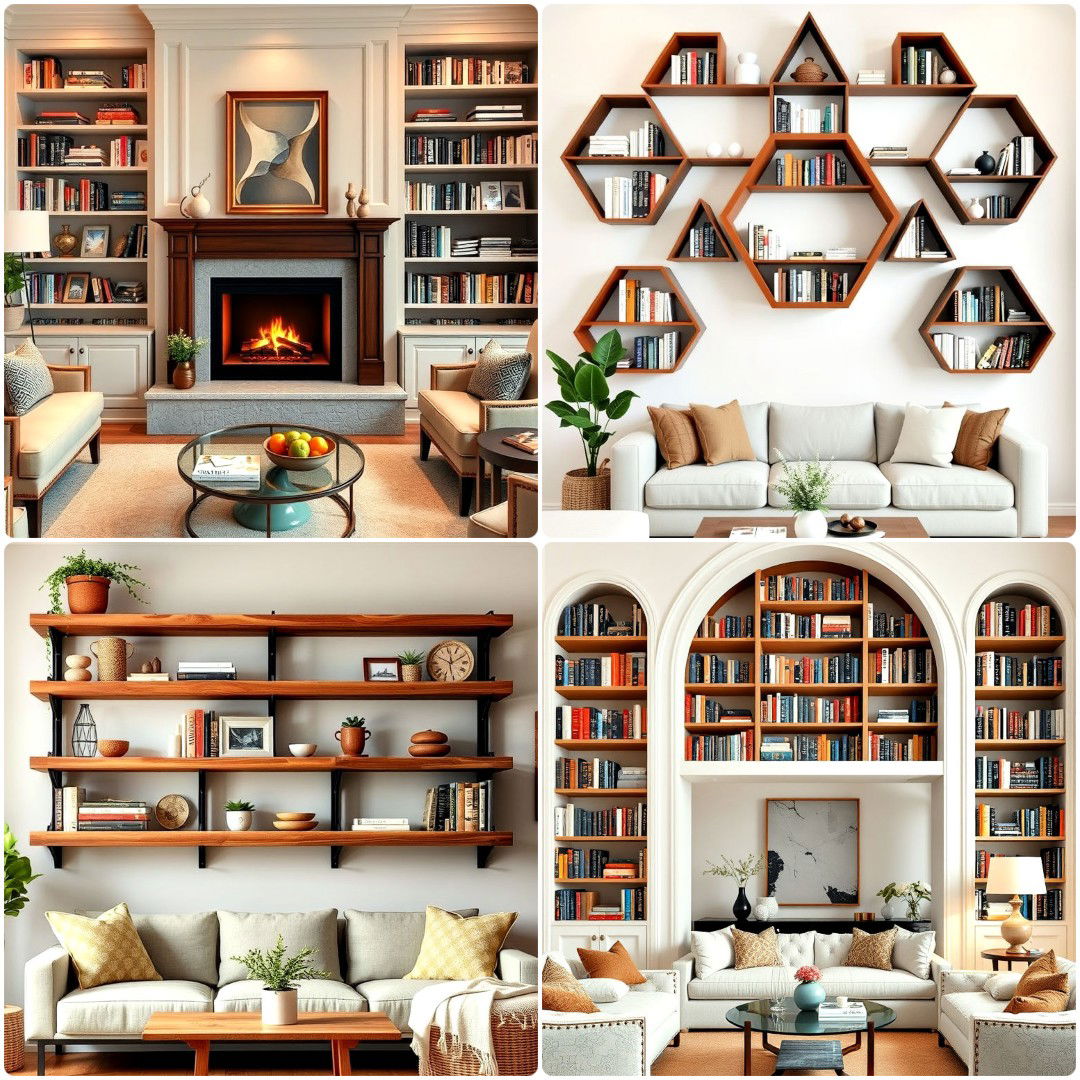
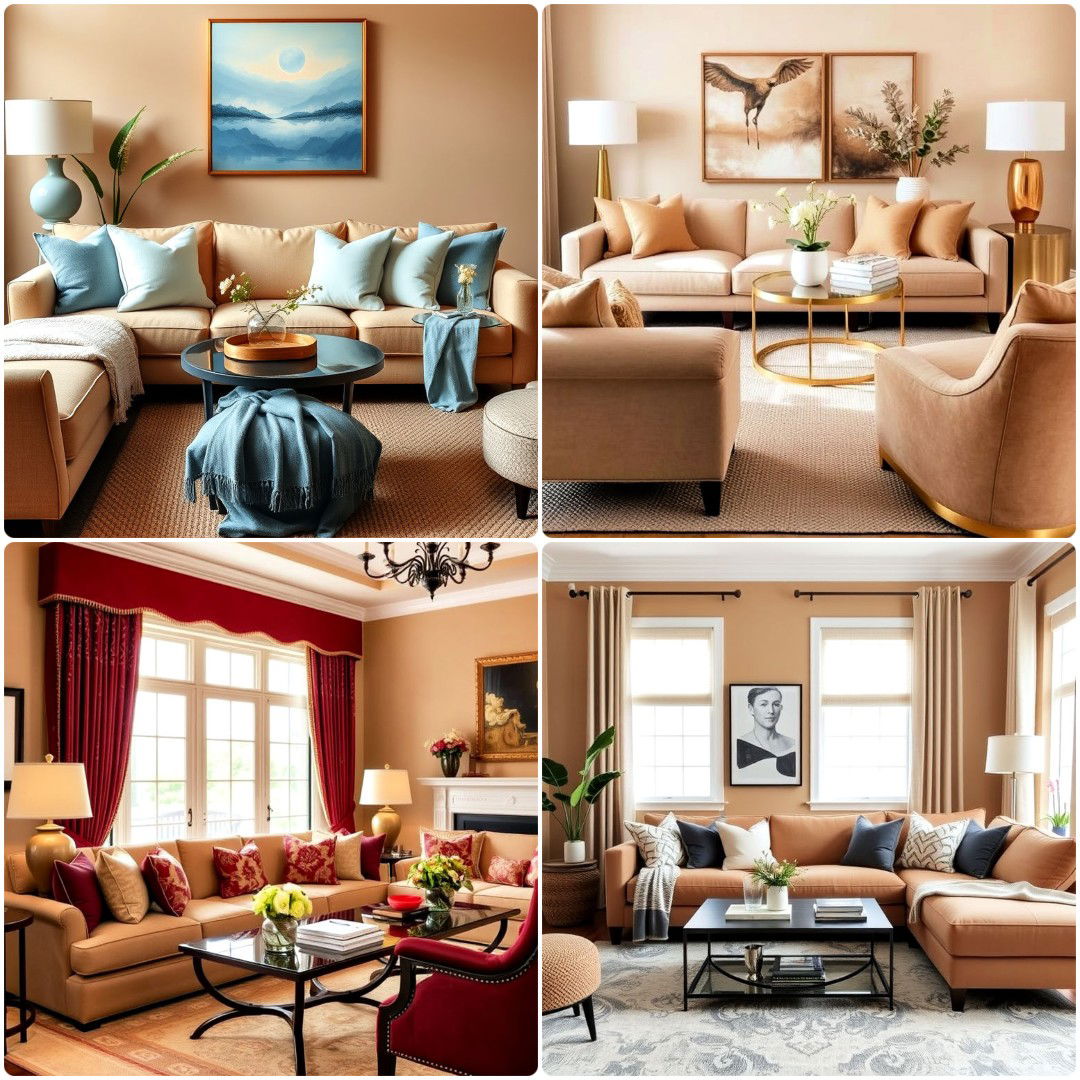
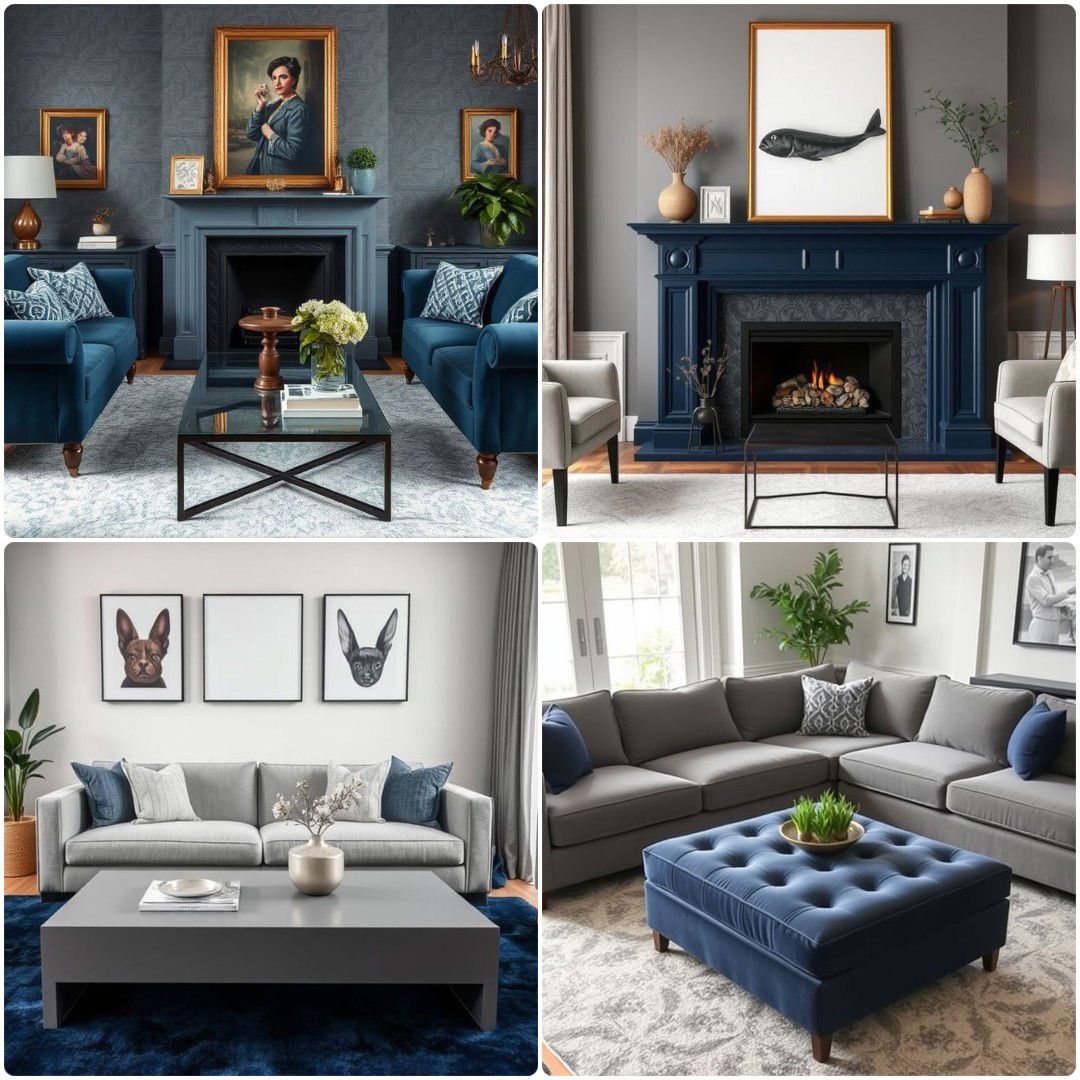
Leave a Reply